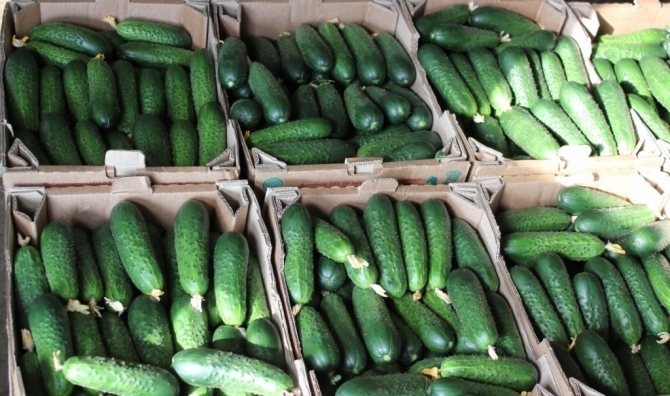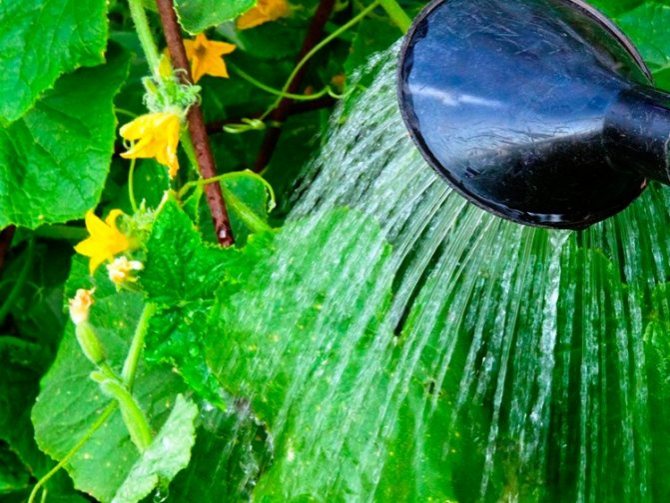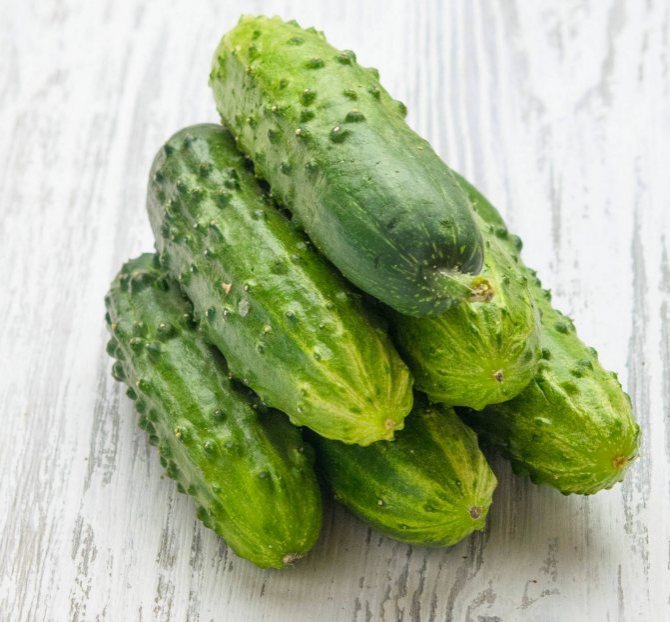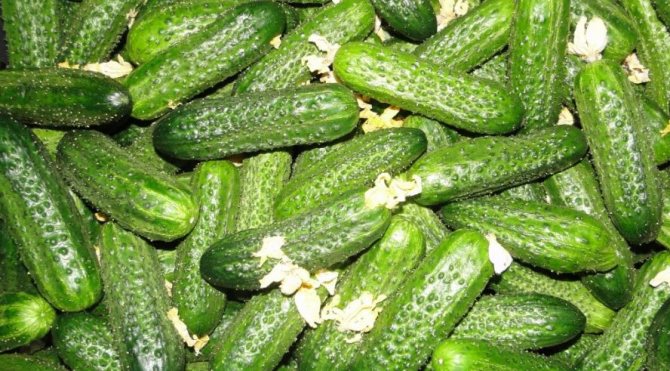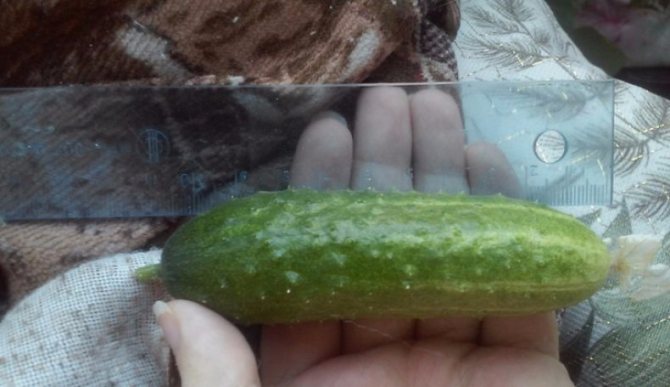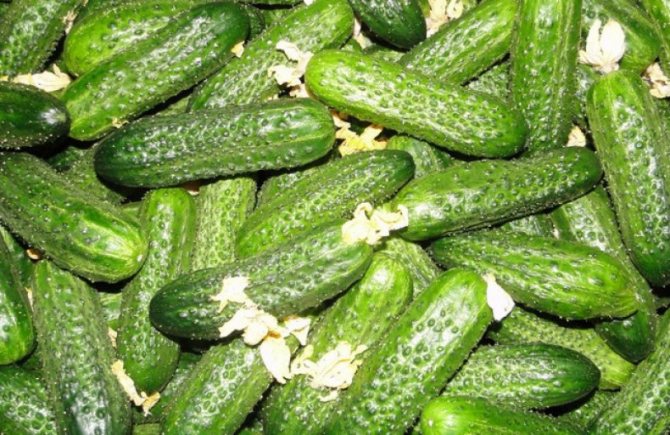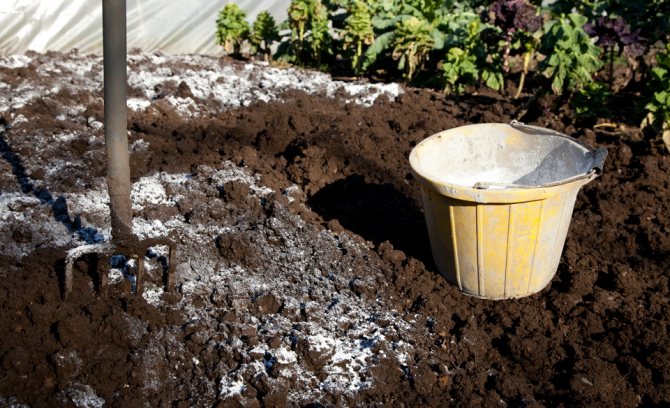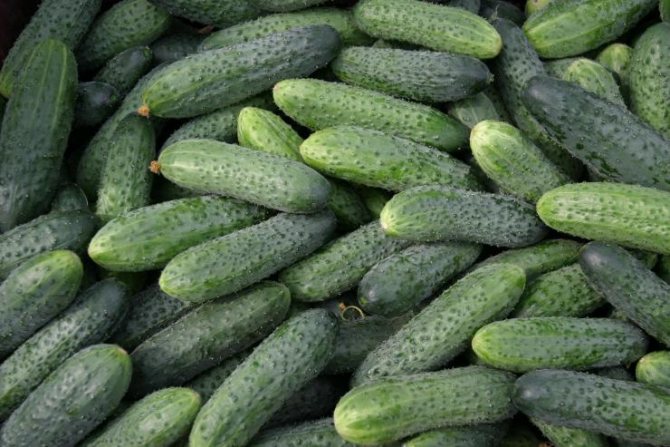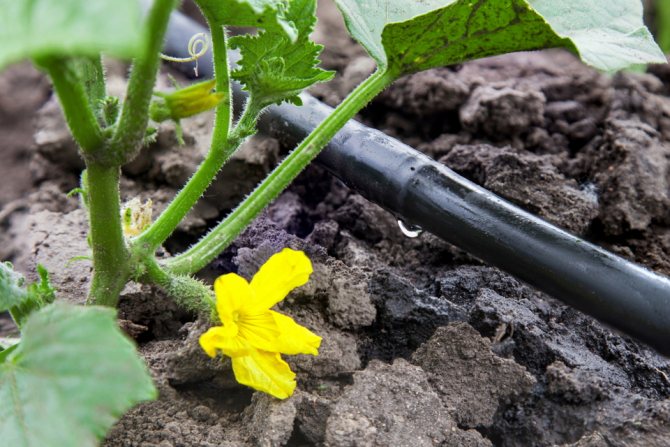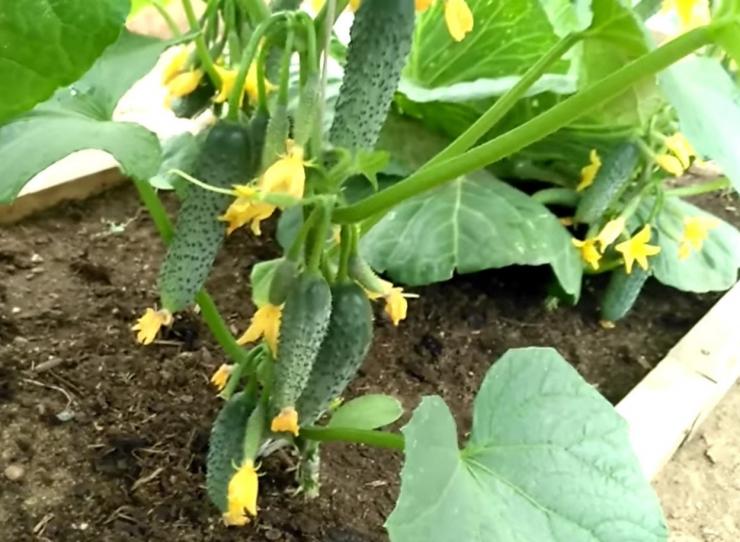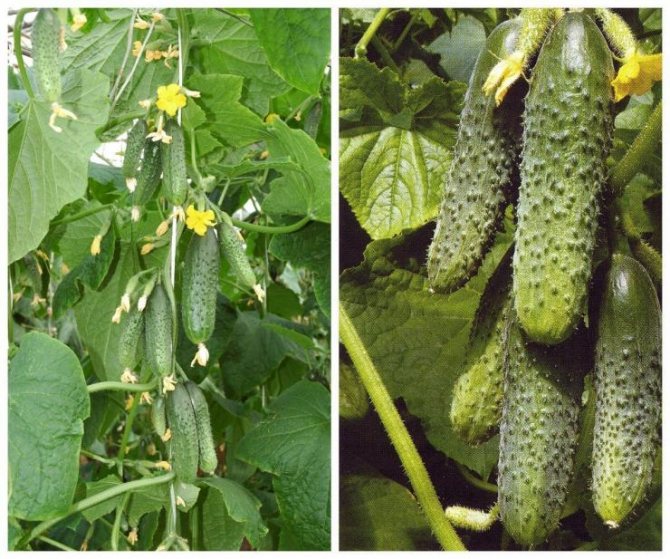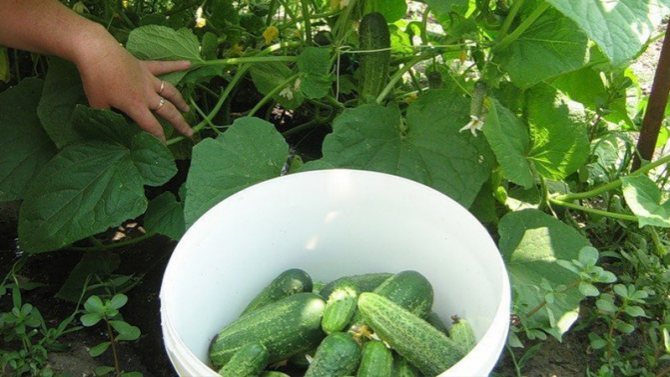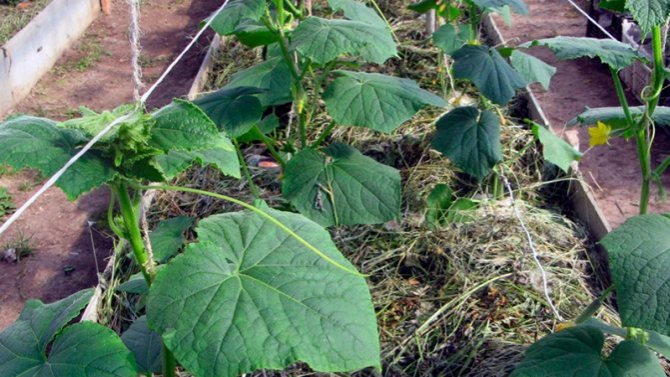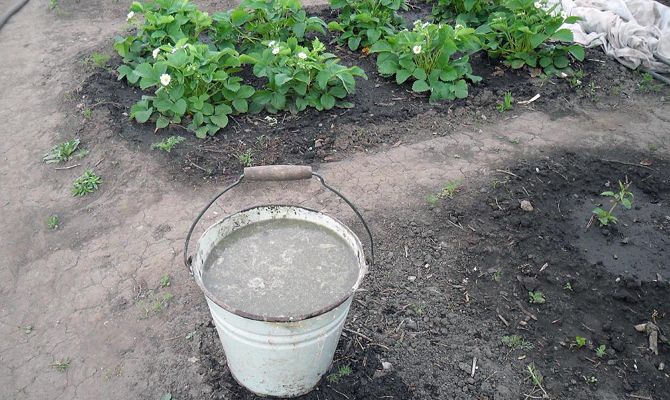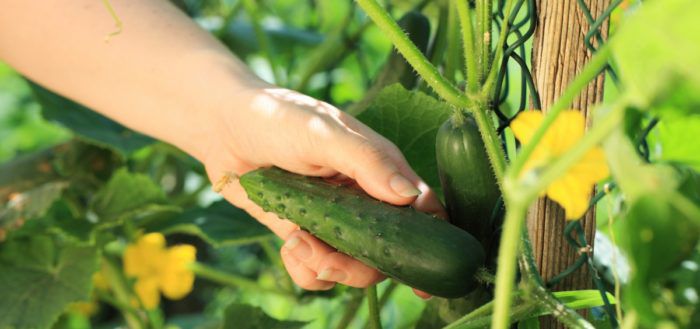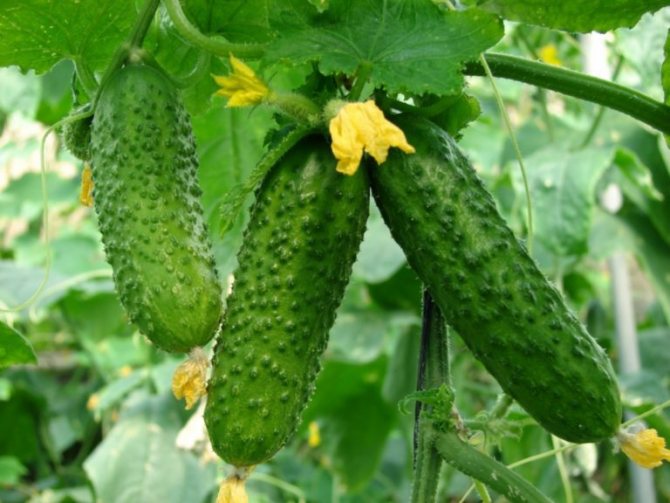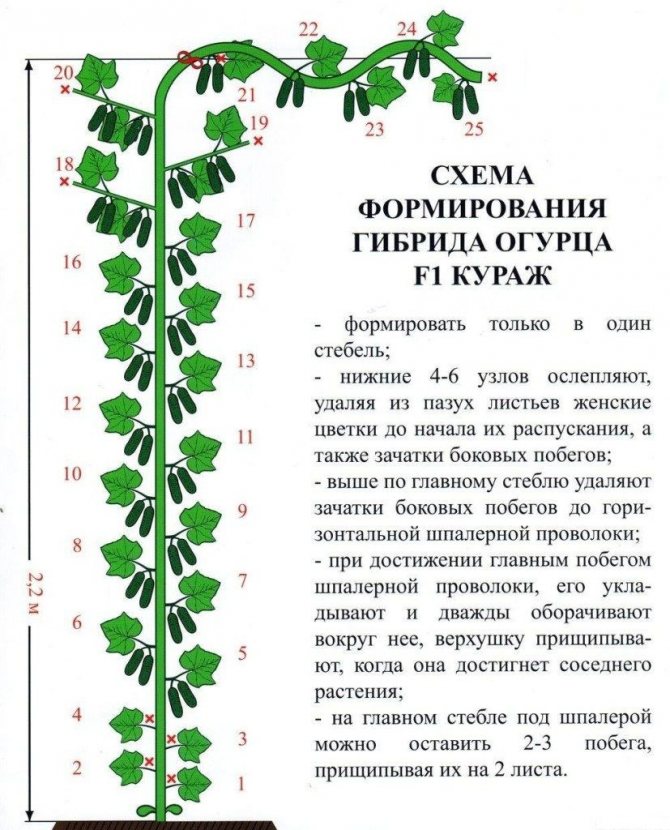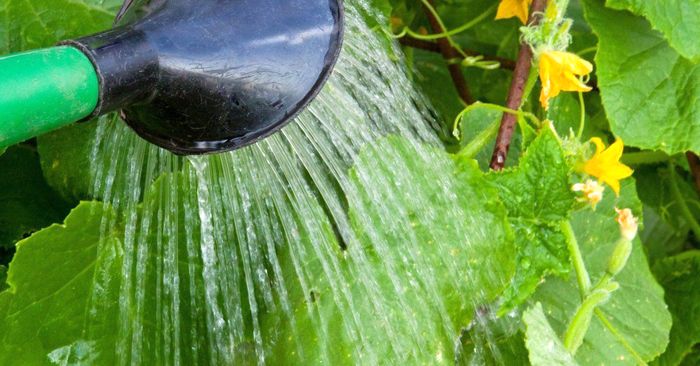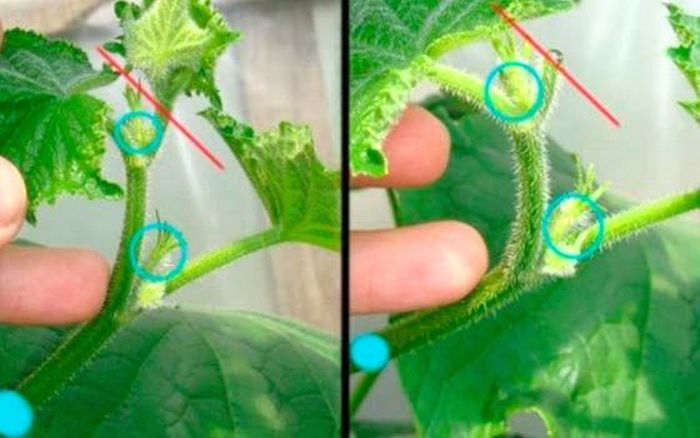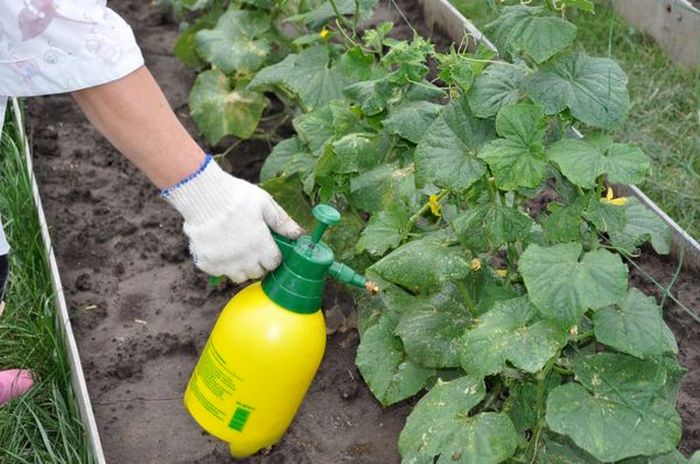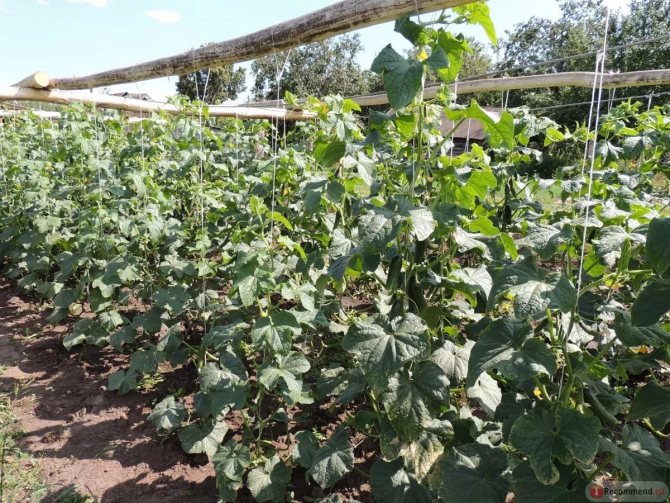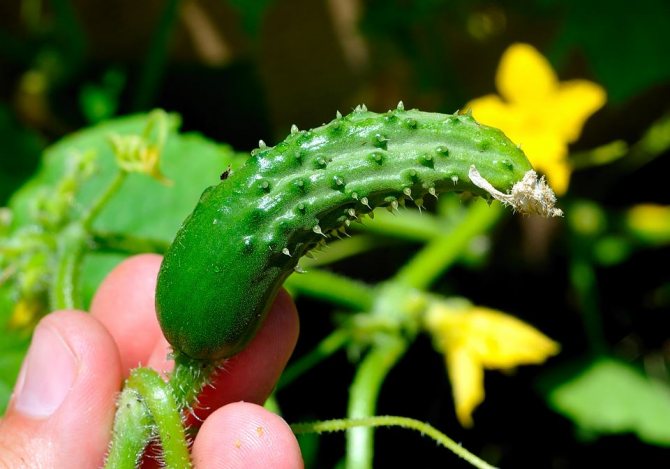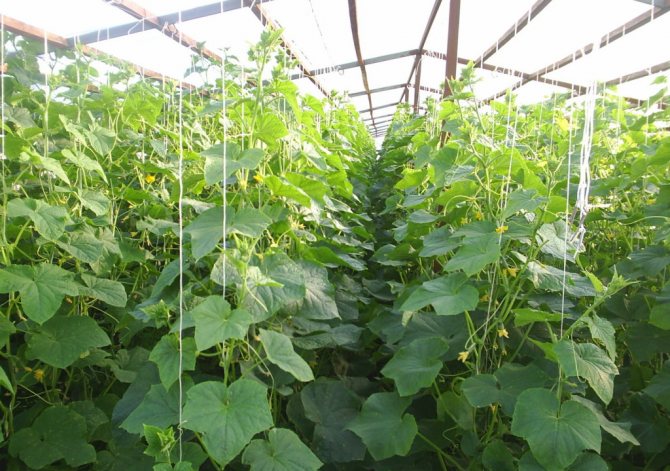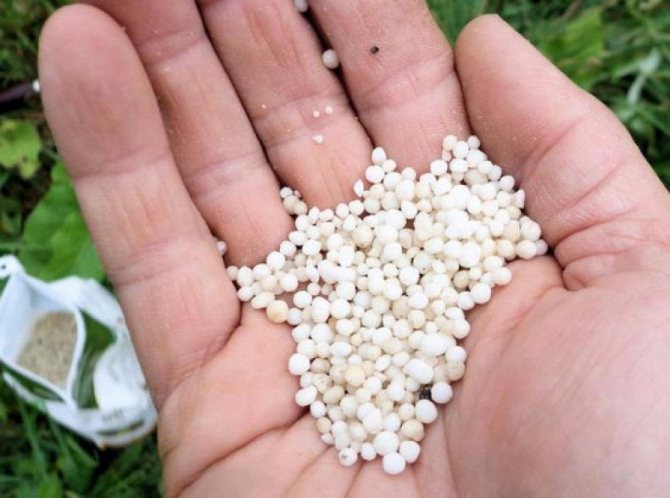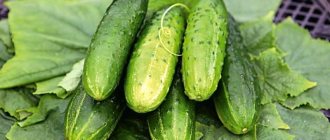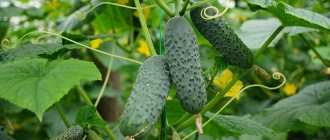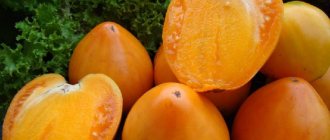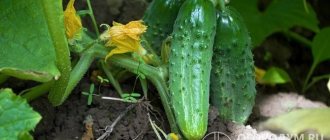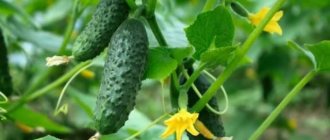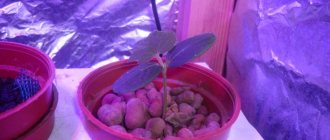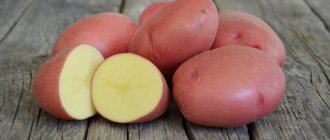Cucumbers are no less popular among compatriots than potatoes. Dishes from them are put on the table almost every day.
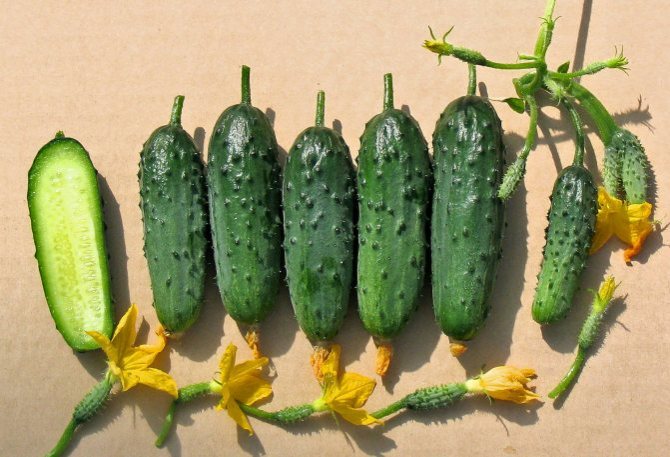
Liana, originally from India, has acclimatized in a temperate climatic zone.
New generation hybrids give stable yields even under unfavorable conditions.
One of these hybrids is the Courage F1. It bears fruit well both in greenhouses and in the open field.
The plant is resistant to disease.
Description of cucumbers Courage F1
Breeding hybrid agro... In 2002, the cucumber variety Kurazh F1 was included in State Register, approved for use in all regions of Russia. Designed for growing under film shelters in personal and small farms.
Hybrid precocious, from germination to fruiting 45-50 days.
Plants parthenocarpic (do not require pollinators), female type of flowering, with bundled ovaries. In the axils of the leaves, depending on the light conditions, from 2–3 to 8–10 ovaries and more are formed.
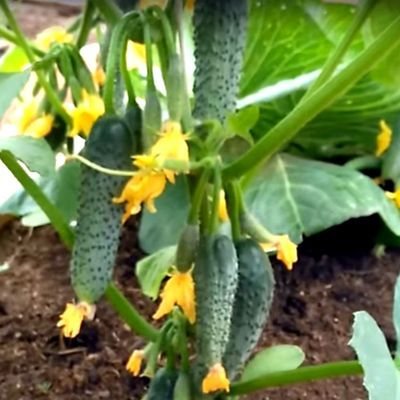

The plants are vigorous in height, the shoot-forming ability is average.
Zelenets weighing 120-130 g, 12-15 cm long, dark green with light stripes, white-spiked, tuberous. Plucked cucumbers do not lose their properties for 10 days.
Fruits not harvested on time do not outgrow.
The pulp is crispy, aromatic, tender, tasty, sweetish. But still, in terms of taste, Kurazh is inferior to salad and bee-pollinated varieties.
Cucumber is a universal type of use, suitable for fresh consumption, pickling, pickling, canning.
The yield of marketable fruits is 16-18 kg / m2 (6-8 kg per plant)
Hybrid Courage F1 is stable downy mildew tolerant to downy mildew and root rot
Features and characteristics of the Kurazh F1 variety
The homeland of cucumbers is India, but the miracle vegetable thrives in most climatic zones. To get a full harvest, you must follow certain rules for planting and caring for the crop. The Kurazh variety is a self-pollinated hybrid with a high yield and is one of the latest developments in breeding. Plants enter the fruiting period 50–55 days (winter) and 35–40 days after germination in spring and summer.
The Kurazh variety is a medium-sized shrub with a well-developed root system. With proper illumination, bundles of ovaries (from 2 to 10) are formed in the axils of the leaves. The fruits, covered with small tubercles and white thorns, have a cylindrical shape up to 13-14 cm in length and weigh up to 130 g. The flesh of the cucumbers is fragrant and crunchy, absolutely without bitterness.
Photo gallery: from seed to harvest
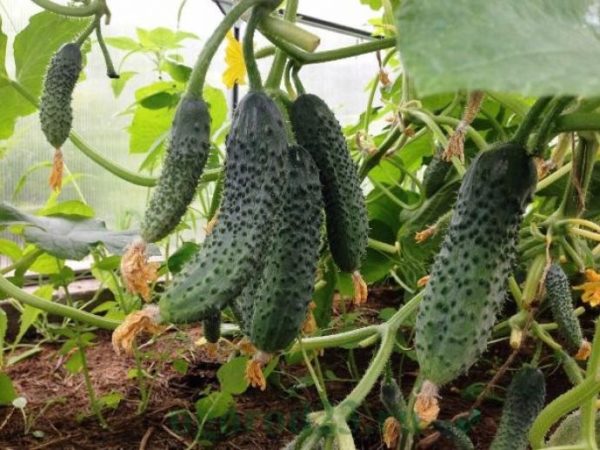

Harvest cucumbers in the greenhouse


The first flowers appear on the main stem
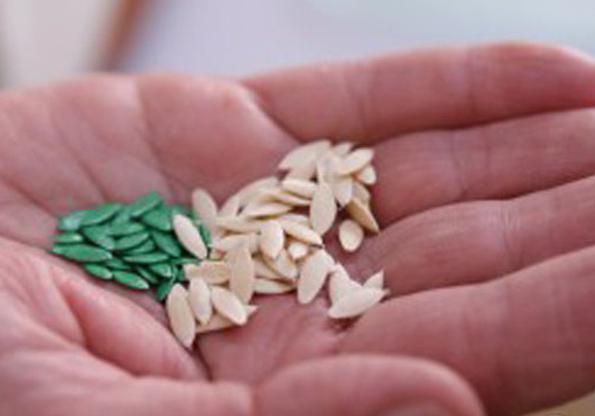

Processed (colored) and untreated (light) seeds
Getting seedlings
The preparation of the material does not differ from the seed method. In March, it is dried, disinfected, germinated and sent to a mini-greenhouse or peat tablet.
The container is kept at a temperature of 25 ° C until germination.
Then the seedlings are transferred to a cooler place so that they do not stretch out.
In the phase of two true leaves, they are fed with ammonium nitrate.
Potassium sulfate must be added immediately before planting.
Advantages and disadvantages
Benefits:
- Parthenocarpic plant (no need for pollination by bees);
- Stable yield in all weather conditions, the ability to grow in different climatic conditions;
- Hybrid Courage, thanks to sustainability to unfavorable weather factors, perfect for growing in the second turn;
- High taste qualities of fresh and canned products.
Disadvantages:
- Demanding to growing conditions and care: you can get the laid high yield only with intensive care for plants;
- According to reviews, despite the unpretentiousness, in open ground growing this hybrid fails;
- The presence of voids in the fruits and the appearance of bitterness with insufficient watering.
Pros and cons of the variety
With the summer and early autumn turnover, the Courage hybrid exhibits the following qualities:
- Early and short ripening period;
- Development of a powerful root system;
- Disease immunity;
- Rich harvests;
- Excellent taste and presentation.
In the summer, the cucumbers are of a denser consistency, crunchy. Their transportability is excellent.
Speaking of the minuses, the greatest difficulty is the formation of a bush. Insufficient watering is the reason for the appearance of voids and bitterness in the fruits. Also, beginners are discouraged by the rather high price of seed.
Seed preparation
Caring for a good harvest begins with the selection of quality seeds. As a rule, the seeds of hybrids offered in stores are already prepared and disinfected, therefore they do not need additional preparation. If the seed has not been processed, it is necessary to carry out mandatory pre-sowing measures, consisting of several stages:
- sorting seeds with a saline solution: water - 1 liter, salt - a tablespoon with top. Dip the seeds into the solution for 10 minutes, remove all floating ones, rinse the rest with water;
- disinfection - protection of plants from diseases. In a solution of water - 100 ml and potassium permanganate - 1 g, soak the seeds for 30 minutes, rinse with clean water;
- soaking - will help the sprouts to pass through the shell of the grain. Wrap the seeds in cheesecloth and lower them in a saucer of water so that the liquid barely covers the cheesecloth, otherwise a large amount of water will prevent the seeds from breathing;
- hardening - will help plants adapt to colder temperatures after sowing. Wrap the seeds in damp gauze and put them in the refrigerator at 0 ° C for two days. In this case, it is important that the seeds are not germinated. After this procedure, the seed is ready for planting.
Characteristics and description of the variety
The Kurazh F1 variety is grown throughout Russia, only the planting time and the amount of harvest differ. In the northern regions, the culture ripens later and yields fewer fruits. Cucumbers grow large - up to 18 centimeters in length. The fruit tastes excellent, but non-hybrid varieties are considered to have the best palatability. The species does not need pollination, the ovaries are formed from their own pollen.
Ripening period of cucumbers
Cucumbers of this variety ripen early - a month and a half after planting the seeds. When sown outdoors in summer, the first crop is obtained after 35 days.
Yield
The popularity of the variety lies in its main advantage - high yield. Up to 18 kilograms of fruit can be harvested from one square meter. With proper cultivation, up to 10 kilograms of cucumbers are harvested from the bush per season.
Cucumbers Courage planting and care
This hybrid is grown according to generally accepted agricultural practices. But in order for the plants to show their full potential, the following important points must be taken into account:
- Hybrid Courage F1 Enough photophilous, therefore, in low light, browning and dying off of the root system is observed;
- According to reviews of many gardeners, this hybrid shows the best results on fertile soils and with regular feeding;
- Plant formation is underway in one stem... In the axils of the first 4 - 6 leaves, all lateral shoots and ovaries are removed. Thanks to this, the plant directs all its forces to form a strong root system and a powerful leaf apparatus. Starting from the 5th - 7th leaf until the plant reaches the trellis (2.2 meters), only the lateral shoots are removed in the axils, leaving all the ovaries. Further, the plant is directed along the trellis and pinched the top when it reaches the neighboring plant. In 2 - 3 nodes under the trellis, in addition to the ovaries, you can leave the shoots, pinching them after the 2nd leaf. This shaping provides maximum illumination and promotes the establishment of a large number of ovaries;
- An important point: overexposing cucumbers on the plant is not worth it, regular collection of fruits allows it to form more ovaries, due to which the yield will increase.
Cucumber care rules
F1 Courage requires stem formation. If the side shoots and leaves are not removed, the plant will turn into dense thickets. Cucumbers need support. The hybrid is best grown on a trellis.
Watering
In the dry summer season, the plants are watered abundantly (every other day). Watering is carried out in the evening. One plant takes about 5 liters of water. It is advisable to irrigate the leaves and the ground around the cucumbers. The culture needs abundant watering at the time of ovary formation and fruit ripening. Cucumbers on such days are watered every day. It is advisable to use non-chlorinated water. Rainwater is best suited for irrigation.
Top dressing
At the time of planting cucumbers, organic fertilizers and minerals are introduced into the soil. After two weeks, you can feed the plant with nitrogen fertilizers (30 grams of urea per 10 liters of water). At the beginning of flowering, cucumbers are fertilized with an infusion of meadow grasses and wood ash. At the time of the formation of ovaries, the culture is not given nitrogen fertilizing. These days, the plant is fertilized with potassium and phosphorus. For 10 liters of water, take 35 grams of superphosphate and potassium sulfate.
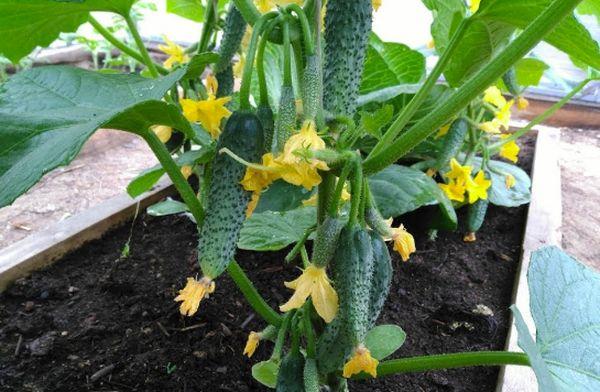

Lighting
The bushes grow upward, and in order for the fruits to receive enough light, the side shoots and excess leaves are removed. The plant needs to be provided with optimal lighting. Dense overgrown bushes growing in the shade of tall trees will bear bitter and small fruits.
In winter greenhouses, the Courage F1 needs artificial lighting. Daylight hours should last at least 12 hours. Cucumbers in such conditions ripen a little later than summer (50 days after the emergence of sprouts).
Sowing cucumber seeds in open ground
Sowing material is sown in mid-May. Growing in the open field of the Courage variety has its advantages.
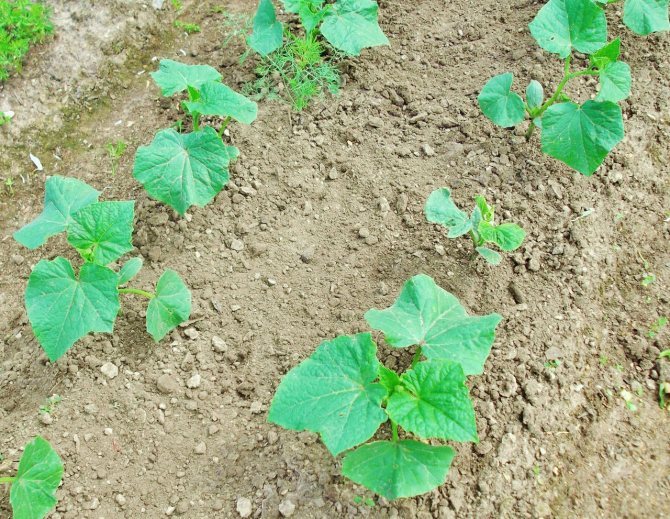

The bushes form a powerful root system.
In plants, immunity becomes stronger, they tolerate cold better than others.
For the first time, you will need a covering material.
It will warm the earth on cold nights and protect it from moisture evaporation.
Sowing in several stages, at different times, will prolong the fruiting period.
Seed preparation
Heat treatment has a positive effect on the seeds, increasing the quantity and quality of the future harvest.
The material is immersed in warm water for 20 minutes. You can warm it up in the oven.
The seeds are spread in a thin layer on a baking sheet and sent to the oven for 3 hours at a temperature of 60 ° C.
During this time, they are mixed several times.
After drying, it is the turn of disinfection.
For the solution, you need a gram of manganese and half a glass of water.
The inoculum is immersed for 20 minutes and then washed with running water.
For the third treatment, biostimulants are used.
They are also able to speed up the formation of fruits.
A solution of methylene blue, zinc sulfate, copper sulfate, baking soda or boric acid is suitable for cucumbers.
The seeds are immersed for a day, after which they are dried.
You can harden the material. For this, the swollen seeds are sent to the refrigerator for 4 days.
The temperature should be -3 ° C.
Plants, the seeds of which have been hardened, begin to bear fruit a week earlier than the due date.
If the seeds are treated with the fungicide "Tiram", that is, they have a green or pink color, the treatment is not performed.
Such seeds are sown dry, directly into the soil.
Dates and choice of location
In the south of Russia, Courage F1 is sown in mid-May.
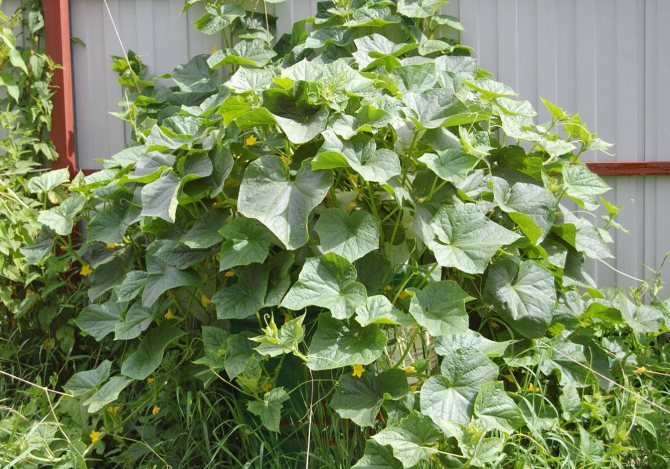

The optimal timing for the middle lane falls on the 25th.
Primorsky, Khabarovsk Territories, Kamchatka and Sakhalin should start work no earlier than late May or early June.
It is necessary to find a dry and lighted place on the site that would be protected from the winds.
The culture grows well on fertile loamy soils. Acidified land leads to a decrease in yield.
You can sow cucumbers in the ridges. Fallen leaves, fertile soil and rotted manure are laid in layers, sprinkling each with urea.
The plant will be warmer in the ridges than in the garden bed.
Role of predecessors
Observance of crop rotation will ensure the health of the plant, and increase the amount of the crop.
You cannot grow cucumbers in the same place for more than one year.
Over time, phytopathogens accumulate in the soil. These are factors that are bad for annual crops.
Fungi, bacteria and viruses act as phytopathogens.
Courage F1 does not like the neighborhood with nightshades, for example, tomatoes and potatoes. These crops have significantly different agricultural techniques.
The plant is oppressed by odorous herbs:
- hyssop,
- basil,
- oregano,
- cilantro.
Cucumbers thrive alongside peas, corn, beans, and cabbage. Eggplants and peppers can be planted nearby on the beds.
Garden bed preparation
Cucumber Courage is picky about the soil, so it must be prepared in advance.
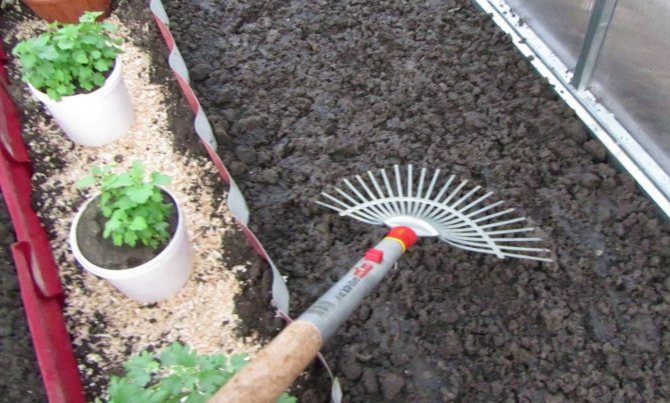

The first step is to find out the acidity. The culture is actively growing if the indicator is 7pH.
Planting cucumbers
Seed and seedling preparation
The germination and yield of any crop depends on the quality of the seed, therefore it should be bought only in specialized stores or from the official representatives of the manufacturer. The bag must be tight and complete, without any defects. Otherwise, you can only wait for the occasional germination of cucumbers. When purchasing seeds of the Courage F1 hybrid, focus on what information is indicated on the package:
- manufacturer's name, registered trade mark;
- batch number;
- information that the product has passed the appropriate certification;
- bag weight;
- piece quantity of seeds.
It is undesirable to use seeds collected on your own, because the hybrid is not able to maintain the qualities received from the parents. That is why artificially bred crops only have an F1 mark, which means the first generation. It is impossible to find a hybrid F2 or F3 of Courage cucumber.
Before sowing, check the quality of the purchased seeds. To do this, immerse them in a container of plain water for a few minutes, although some gardeners advise a saline solution: 30 g of salt per 1 liter of water. In any case, good specimens will sink to the bottom of the dish, and empty or spoiled ones will end up on the surface.
Usually branded seeds from the manufacturer are treated with special preparations that accelerate germination. However, if you deem necessary, you can additionally soak the calibrated seed, for example, in Epin-extra solution. This biostimulant and adaptogen will help not only mitigate the effects of frost on the plant, but also protect it from some diseases, as well as accelerate the ripening of fruits and increase the yield of cucumber.
If you intend to use any growth promoter available to you, carefully follow the instructions on the package. For different crops, the concentration of the solution and the soaking time are different, and overdoing even with a biological preparation is dangerous for the future harvest.For example, Epin for cucumbers is prepared as follows: take 1-2 drops per 100 ml of water with a temperature of about 20 ° C. The solution is made 1–2 days before sowing, and the seed is kept in it for 18–20 hours. You can also warm up the seeds by wrapping them in napkins and spreading them on central heating radiators for a maximum of 30 minutes. Sometimes, a couple of days before sowing, they are soaked in ordinary water, giving the opportunity to hatch.
When using any method of seed preparation, try not to overdo it. Some summer residents recommend not to warm up or soak the seed at all if you are planting a hybrid.
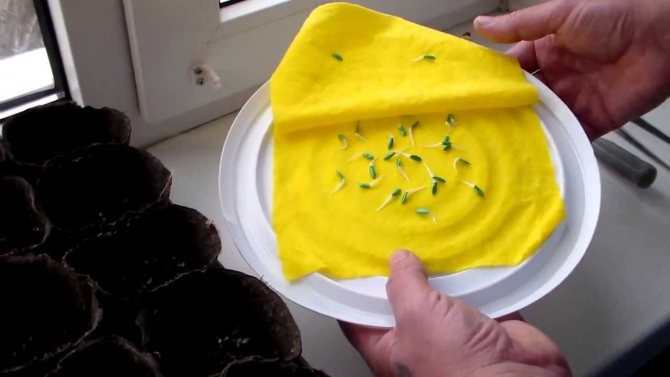

To test the germination of seeds, they can be pre-germinated with a damp cloth.
Finished seeds can be sown directly into the ground: in a greenhouse or in a garden bed. In the first case, this is done not earlier than the end of April, and in the second - from mid-May. If you are used to growing cucumbers with seedlings, then you need:
- Prepare peat or plastic pots. Individual containers will allow you to skip the diving stage, which is not always to the liking of cucumbers, since it weakens young shoots.
- Fill them with fertile soil. It is advisable that its composition coincides with the soil in which you will plant the grown seedlings.
- Bury the seeds no more than 1.5 cm.
- Cover with foil and place in a warm, well-lit place.
- Provide sufficient watering so that the soil does not dry out, but does not remain too wet. Cucumbers love warm water.
- After the appearance of the second true leaf, you can increase the intensity of watering. To prevent the seedlings from pulling out, you need to lower the room temperature to 15–20 ° C.
- Somewhere 3-4 days before planting, you can put sprouts in pots on a balcony or veranda, but only if they are not exposed to direct sunlight, and the temperature is not lower than 15 ° C and there are no night frosts.
Seeds for seedlings are sown about 2–2.5 weeks before planting in a permanent place.
Greenhouse or open ground - choice of location
Experts who bred Courage advise planting a hybrid in a greenhouse in order to get the maximum amount of harvest. Greenhouse preparation should begin in advance, in the fall. As a rule, it consists of the following stages:
- Cleaning of the remnants of those crops that grew earlier, as well as weeds.
- Watering the soil with fungicides.
- The introduction of organic or mineral nutrients. It is good if there is a compost heap on the site - an inexhaustible source of fertilizers for soil and plants without chemicals.
In the spring, the soil in the greenhouse should be disinfected. The safest for the earth itself, as well as for human health, are the following methods:
- watering the beds with steep boiling water, and then covering them with a film;
- disinfection with a strong solution of potassium permanganate;
- the use of special non-toxic drugs that are sold in specialized stores.
About a week before planting the plants, after disinfection, you need to feed the beds with fertilizer.
When re-cultivating Courage for one season (in the summer-autumn period), the land in the greenhouse should be cultivated with Topaz or Quadris, Farmayod in order to reduce the likelihood of plant disease with viral and bacterial infections.
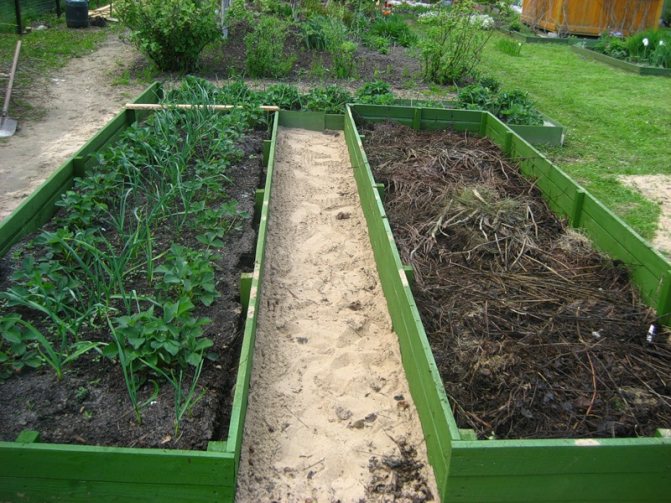

Neat warm beds will help adapt plants to weather conditions
The preparation of open ground for future cucumber plantations should also be carried out in the fall. First, choose a lighted area that is protected from drafts. Loosen the soil and add manure or wood ash to it. In the spring, about a month before planting Courage, arrange warm beds on this place, laying out fallen leaves, manure or compost and fertile soil in layers. Sprinkle everything with urea and water.
You can lay the first layer of thin branches left after cutting the trees, then compost or plant waste, and finally the soil.Often, all this is poured with an infusion of ash, taking 1 glass of raw materials in a bucket of water, or with a solution of the drug containing effective microorganisms. Cover with black foil on top. Such beds will protect vulnerable cucumber sprouts from frost and will give a good start to the formation of the future harvest. 2-3 days before the planned sowing or rooting of seedlings, it is necessary to disinfect the soil using any of the methods discussed above.
The soil for Courage should be well-drained, light, loosened and fertile. Best of all, if it is black soil, loam or gray soil. Sour soil can affect the amount of the crop, so you must first sprinkle it with lime powder and dig it up.
Competent landing
Seedless way
This is more suitable for polycarbonate greenhouses. When planting in open ground, you need to wait until the threat of repeated frosts has passed, and the average air temperature will be at least 12-15 ° C. In some regions, this is the beginning of June, but more often it is still the middle or end of May.
The prepared seed should be buried 2–4 cm: a little less for a greenhouse, more for unprotected beds. An individual hole is made for each seed. The distance between the pits should be about 50-60 cm. In the open field, the crops are covered with foil.
The seedless method reduces costs at the preparatory stage, but delays the start of fruiting a little.
Seedling method
This method is suitable for both greenhouses and open ground, therefore it is ubiquitous. It allows you to speed up the harvesting process.
How do you know if the seedlings are ready for rooting? She must:
- have 3-4 formed sheets;
- have a well-developed root system;
- be no older than 3 weeks.
The sprouts are painfully enduring the change of "place of residence", so the best way to adapt future cucumbers is to root them directly in a peat pot or in a special tablet in which the seedlings were grown. If the seeds were sown in containers that cannot be buried together with the sprout (for example, in plastic cups or special mesh cassettes), then the seedlings must be removed along with a large clod of earth.
Approximate planting dates: for the greenhouse - mid-April, for open ground - mid-May. Weather conditions play a major role. The scheme also depends on where it is planned to grow Courage: for a greenhouse, these are 2 bushes per 1 m2, for open ground - 2-3.
The best time to root is a cloudy day without rain or an evening when the sun is no longer active. Heat is additional stress for seedlings. The grooves must be made to a depth that allows the roots to be freely positioned. It is not recommended to deepen the hypocotal knee.
In the first 3-4 days, the humidity in the greenhouse should be at the level of 90-95%. In open ground, plantings can be mulched with organic matter (but not fresh grass), and covered with a film on top.
In the south of Russia, it is recommended to grow Courage only by the seedling method.
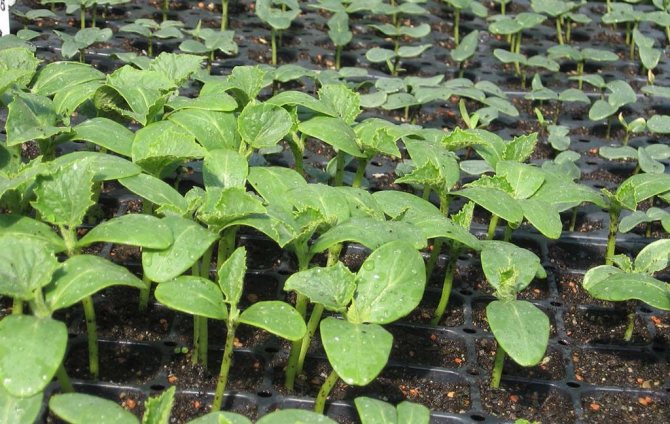

Strong seedlings are the result of proper care
Cucumber Courage f1 reviews
| Marina S. | The variety is very productive. The seeds have never failed, the germination is excellent. We grow in a greenhouse on trellises in one stem. We collect every other day all summer, sometimes in autumn. It is mainly suitable for fresh consumption and sale. For conservation, their cultivation does not make much sense, since they are large enough (10 - 12 cm) and full. You will have to pick unripe cucumbers so that they look beautiful in the jar. But the taste is excellent, smells fresh, crispy. The crust is thin, not coarse, dark green in color, with white thorns. |
| Elenka828 | I also liked the courage, it bears fruit until the very cold, and the cucumbers are very tasty. |
| Ivan_Meylen | I put Courage in the OG I love this hybrid. Beautiful in conservation |
| Galina K | For the first time in 2020, she planted courage, survived under a double spanbond freeze to minus 4, pleased with the taste and a bountiful harvest. Nizhny Novgorod region. |
| ilja | I have been planting courage for more than 5 years (published on January 25, 2015). The hybrid is very stable in terms of good yield, disease resistance and adverse weather conditions, and long-term fruiting. It grows very powerfully, stepchildren need to be pinched regularly, otherwise there will be a forest of leaves and few fruits. Good at workpieces. Fresh also goes well, but inferior in taste to bee-pollinated and salad varieties / hybrids. One of the earliest cucumbers on my site. The first fruits ripen in the greenhouse in early June. For the formation of bouquet ovaries, you need to "feed" it well. |
| Last season, I planted Courage, I did not like it at all, the first one became a victim of a spider mite, compared to other hybrids, it is not at all productive. Judging by the reviews, this hybrid should either be grown in a greenhouse, or the climate should be more humid. | |
| ira-s | Published on June 7, 2020 I have been planting courage for 5 years. I amazed with its yield. I watered him only with water and did not feed him with anything. |
| Larisa S | "Courage" from Gavrish was planted only in open ground. At first I was very happy, then the heat started and he began to dry. I tore him out without much pity. Left to replace "Finger". To taste: cucumbers, like cucumbers. It quickly outgrows, turns yellow. Later, analyzing, carefully reading (!!!), I saw in the recommendations that it was for film greenhouses. So try it! |
What do summer residents say about the variety in question?
Cucumbers Kurazh have been planting for several years in my garden and I really like that they are unpretentious, but they bloom profusely and give a large harvest, of the correct shape, with pimples, are excellent for conservation.
Nadi
This year I decided to feed Courage hard. And only after that he began to "stir" a little, bear fruit normally. This hybrid is just for good oily and nutritious soil and top dressing.
SERGEY
Cucumbers slowly went. So far, only "Courage". Indeed, very sweet, tasty, without bitterness. Thanks to the one who first wrote about them. But my yield is not so hot. But all of them have few cucumbers, our nights are cold.
SinTola
I plant courage for 5 years. I amazed with its yield. I watered him only with water and did not feed him with anything.
ira-s
As usual, "Gavrish" distinguished himself, bought Courage, but it is not known what has grown. And the taste is average.
MaxL
Courage - super cucumbers, I have been planting for 10 years already. There is always a crop, even if all the neighbors do not and they say that it is not a cucumber year, we have them! Know the problems, the main thing is not to buy a fake.
My squaw
Courage is a hybrid that requires attention and constant care. But he thanks a generous harvest for his patience and hard work, so try and be sure that these cucumbers will become one of the most favorite vegetables on your table.
Rate the article:
- 5
- 4
- 3
- 2
- 1
(0 votes, average: 0 out of 5)
Share with your friends!
The Courage variety was bred in India, but the origin does not in any way affect the possibility of its cultivation in our climatic conditions. In addition, the variety feels great with us. Almost all gardeners grow this crop on their site, so it is important to choose the right variety that would give a good harvest and with which you would not have to mess around a lot. In this regard, the Kurazh F1 variety has proven itself well.
Characteristics and features of the variety
Courage F1 refers to early ripening hybrids, bred by Russian breeders, representatives of the well-known company Gavrish. The variety is suitable for growing in greenhouses and open field, however, it feels better under a film cover.
Cucumbers Courage
It was included in the State Register of the Russian Federation in 2002. Can be grown in Ukraine and Belarus. It is recommended to grow both in summer cottages and on farms.
Main characteristics:
- 38-45 days pass from the first shoots to the technical maturity of the fruits;
- the variety is parthenocarpic, that is, self-pollinated;
- the plant is indeterminate, without limiting the growth of the stem;
- flowers are female;
- the ovaries are arranged in a bunch or "bouquet";
- lashes can reach 3 m, densely leafy.
From the description of the plant, you can find out that the variety is high-yielding. On one main shoot, up to 4 cucumbers can be tied at the same time in one knot, up to 8 fruits on the side ones. One plant can produce up to 30-35 cucumbers at a time.
Escape with fruits
The edges of the leaf blades are irregularly serrate, the leaves are medium, colored green. Cucumbers have a cylindrical shape, weigh from 100 to 140 g. The length of the greenery is 12-17 cm, the diameter is 3.5-4 cm. On the dark green skin, a waxy bloom is barely visible, white stripes are weakly expressed. The fruits are tasty, aromatic, sweetish, crunchy.
The advantages of the variety:
- early ripening;
- has a high degree of adaptation to various climatic conditions;
- marketable zelentsy;
- drought resistant;
- good keeping quality and transportability;
- disease resistance;
- simultaneous ripening of fruits.
In addition, the variety has a universal purpose. Zelentsy can be consumed both fresh and used for canning, salt and prepare salads.
Fruit
The disadvantages of the Courage variety can be attributed to the capriciousness of the plant, since it is demanding to care, when growing, the variety needs to form a bush. The lack of fertilizers leads to the fact that empty cavities appear in the greens, and insufficient watering affects the taste - the cucumber of the Kurazh variety becomes bitter.
Growing cucumbers of the Kurazh variety
Ajax cucumbers
Gardeners recommend growing cucumbers through seedlings. Thus, the plant will be able to fully realize the yield inherent in it. Sowing seeds should be carried out in mid-May, planting seedlings in a greenhouse or in a garden bed - in early June. A month will pass from planting to collecting the first fruits.
On a note! Cucumbers Courage are better grown in a greenhouse than in the open field, since they bear fruit better in greenhouse conditions. To save space in greenhouses, shoots are tied to a pre-installed trellis.
Tying cucumbers allows the green mass to bathe in the sun, which has a beneficial effect on the development of fruits. However, growing outdoors makes plants more robust and resistant to various diseases. Cucumbers in the garden have a more powerful root system.
Soil selection and soil preparation for planting
Cucumbers grow best in fertile, loose soil, which contains:
- sandy loam soil,
- fertile black soil,
- loam and forest gray soil.
The bed should be done in a well-lit place, protected from the winds. The vegetable culture does not react well to sudden changes in day and night temperatures, it loves abundant watering. The predecessors of cucumbers can be tomatoes, peas, beans, beans, cabbage.
Garden beds
How to properly prepare the garden
Gardeners recommend preparing a layer-by-layer bed, each of the layers should have approximately the same thickness (5-6 cm). The main layer is fallen leaves. It should be placed first. Fertile soil must be poured onto it with rotted manure or humus introduced into it. Next, 2 layers should be repeated and the topmost one should be poured, which will consist of garden soil and humus or peat in a 2: 1 ratio. Sprinkle urea between layers and sprinkle with water.
Attention! Before laying the next layer, you must wait until the soil has absorbed moisture completely.
Some prepare the bed like this: a layer of soil is removed from the allotted surface to a depth of 20 cm. It is replaced with a mixture of last year's needles mixed with compost, rotted sawdust and straw, finely chopped brushwood and peat. Put humus on top and add 100 g of wood ash for every 1 m2. Above it is necessary to pour a layer of fertile soil 20 cm thick.The first layers can be smaller - 10 cm.
Soil preparation in autumn is slightly different from spring work. At this time, you can simply dig up the bed to the depth of a shovel-bayonet and add rotted manure in a volume of 20 liters per 1 m2, wood ash - 0.5 kg, nitrophosphate - 75 g. With the arrival of spring, the bed will have to be dug again.
Soil preparation
To warm the earth and kill pathogenic microbes, the garden bed is spilled with boiling water and covered with polyethylene.
Sowing seeds
For better germination and increased productivity, the seeds of cucumbers Kurazh are soaked in Epin's solution. For additional disinfection, several crystals of potassium permanganate are added to the liquid.
Sowing is carried out directly to the garden bed, shallowly burying them in the ground. On top of the seeds, you need to pour soil 1.5 cm high, this will be enough. When planting between rows, you must leave a distance of at least half a meter.
Sowing seeds in open ground is carried out only at a time when the ground warms up well and is at least +15 ºC. To maintain the optimum planting temperature, you will need to cover it with a film for some time in order to protect crops from the threat of recurrent frosts and low night temperatures.
Watering
Planting seedlings
When 4 true leaves are formed on young plants and the root system is well branched, then it's time to transplant the seedlings to the garden bed.
After transplanting, it needs to be watered well. Planting should not be thickened, since plants need a lot of space for development and fruiting. It is recommended to plant 3 plants per 2 m2.
Planting is best done on a cloudy day or in the evening. Intense heat can harm the seedlings and by the evening they will wiggle a lot. It will be very difficult for such plants to restore turgor. In addition, an oversight can lead to the development of a disease such as fusarium.
After planting in the greenhouse, it is recommended to maintain the temperature at the same level for several days, and when transplanting into open ground, it is recommended to cover the bushes with foil or spandbond.
Seedling
Care for cucumbers of the Kurazh variety
Puccini cucumbers
The yield of a cucumber crop depends on proper care: timely watering, fertilizing, forming a bush and harvesting, maybe fighting diseases, if any.
How to form a bush correctly
The bouquet of the variety can manifest itself only if a competent formation of the lash is carried out. When 5 leaves at the base of the lash are well developed on the plant, it will be necessary to remove the entire ovary from the axils, only the lateral shoots formed, female flowers, which, unlike male ones, are decorated with stamens. This formation will allow the culture to form a well-developed root system.
Further, in the next 2 nodes, only the ovary will need to be left, all shoots that will move to the side must be cut off.
Further, it is recommended to pinch each sheet. The top must also be pinched when it reaches the top of the greenhouse.
Foliage pruning is carried out if there is an abundant build-up of green mass. Such a procedure is necessary for thinning the bush so as not to provoke the development of powdery mildew or other diseases.
Bush formation
Proper watering is the key to a good harvest
The short-fruited cucumber of the Kurazh variety is a moisture-loving plant. If you provide them with sufficient watering, there is no doubt about getting a large harvest.
You need to water it with warm water 2 times a day: in the morning and in the evening, with an interval of 2 days. It is recommended to pour up to 4 liters of water under one adult plant.
It is recommended to water not under any specific bush, but to moisten the soil surface between plantings. Thus, it is possible to ensure uniform soil moisture and not expose the surface root system of the plant.
Watering
When growing cucumbers outdoors, it is recommended to water depending on the weather conditions. If the weather is hot, watering is carried out in the evening, every day.In rainy weather, cucumbers do not need watering.
Watering is necessary:
- during the formation of new ovaries;
- after harvesting the fruit;
- during mass fruiting.
If the foliage is withered, the plants need watering, even though the time has not yet come.
Fertilization
During the growing season of development, cucumbers need 4-fold feeding. You can carry out root dressing and foliar dressing, by spraying with mineral fertilizers dissolved in water, over the foliage.
Fertilizer
It is advisable to apply fertilizers in the evening, after the next watering or after the rain has passed.
Harvesting and storage rules
Cucumbers Sankina Lyubov
The first fruits appear in mid-July. With proper care, up to 10 kg of vegetables can be harvested from one bush. When planting 3 bushes per 1 m2, the yield will be up to 20 kg.
Important! You should not wait for the full maturity of the cucumbers. Vegetables must be harvested still unripe, since full ripening is allowed only if the goal is to collect seeds.
Harvesting is carried out 1 time in 2 days. If the cucumbers are overexposed on the bush, their taste will deteriorate, bitterness will appear, and the skin will become tougher. In addition, untimely harvesting slows down the ripening of freshly set fruits.
The first greens are recommended to be removed when their length reaches 10 cm. This is necessary to stimulate the formation of fruits, and not for the development of the bush and the growth of green mass.
Cucumbers are best picked early in the morning or late in the evening. During this time, it can be ensured that the vegetables are firm and do not contain empty cavities. During collection, you cannot pull the cucumbers and twist, trying to detach the green from the stalk. It is recommended to work with scissors, as the stalk should remain on the growing shoot.
The collected fruits do not lose their presentation, taste within 8-9 days, only they must be removed to the basement, where it is dark and humid. Additionally, you need to cover the cucumbers with a dark non-woven material, you can use burlap.
Care
Taking into account the fact that the skin of cucumbers of the Courage variety is rather thin, when stored at room temperature, vegetables will lose their turgor for 2 days, they will be flabby and lethargic.
Pests and diseases: control measures
The undoubted advantage of the Courage variety over other representatives is that they are not very susceptible to pests and diseases. If, nevertheless, some kind of attack has overtaken, it is recommended to start the fight in time so as not to ruin the entire crop. Here are the most common diseases that cucumbers suffer from and try to consider the pests of vegetable crops.
- Cladosporium. The appearance of gray-brown spots on the leaf plates indicates the presence of this disease. Through holes are formed in the affected areas, the leaves die off, the plant lags behind in development. For prevention purposes, it is recommended to thin out the plantings, remove dense foliage. You need to treat it by spraying the borage with a solution of Bordeaux liquid. Requires 2-fold treatment with an interval of 7-9 days.
- Anthracnose. Dead areas can be observed on the leaf plates. The fruits become twisted, dents with pink mucus form on the sides. Vegetables acquire a bitter taste, it becomes impossible to eat them. Copper oxychloride is used for spraying. You cannot pick vegetables during processing.
- Thrips. Mass damage by thrips leads to the death of the planting, since small insects feed on borage juice. It is possible to determine that a shallow sucking insect has started on the plants by the rapidly growing yellow and beige spots. If you do not start treatment, the bush will dry out. For prevention purposes, it is recommended to dig up the beds every autumn to the depth of a bayonet-shovel and spray with a solution of Actellik or Kabofos preparations.
Of the folk remedies for combating the pest, the most effective way can be called - the treatment of plantings with hot pepper infusion.
Cucumbers Courage is a high-yielding multi-purpose variety. With the observance of agricultural technology, you can get a good harvest. Zelentsy are suitable for fresh consumption, for canning, salting, and retain their presentation for a long time.
Reviews of summer residents
- The variety is common and in demand among many gardeners. Grows well in the greenhouse and in the garden. A good harvest can be grown in just 38-40 days. There are many female flowers on the plants. Therefore, from 1 sq. m. can be collected up to 14 kg. fruits. The fruit tastes good. The variety is excellent for conservation.
- I have been growing this variety in the country for a long time. Plants are medium-sized with strong foliage. One plant can ripen up to 30 fruits. The harvest is good. From 1 sq. m. I collect 10-13 kg. fruits. In order for the harvest to be good, you need to form shoots on time and properly feed. Good grade.
- I grow this variety only in a greenhouse. Plants grow rapidly and have many female flowers. The variety loves feeding in the form of a liquid mullein or a solution of bird droppings. When growing in a greenhouse, you need to pay attention to the correct formation of plants and timely watering. From 1 sq. m. I collect stably at 12-14 kg. fruits.
- I really like this variety. The yields are always high. From a plant, you can pick up up to 8 kg. fruits. I use the grown crop for various salads and for preservation. The fruits are beautiful to look at and delicious. In some years, the fruits weighed up to 125-140 g. The pulp, in ripe fruits, is crispy with an exquisite aroma.
Formation of a bush variety Courage
The main technique that allows you to collect the maximum yield from the bundle varieties of cucumber is the formation of a bush into one stem. To do this, first remove all lateral shoots that begin to grow and ovaries in the axils of the first 4-5 leaves. As a result of this technique, the cucumber plant begins to direct all its strength and growth energy to the formation of a powerful root system and a large number of leaves in which nutrients are stored.
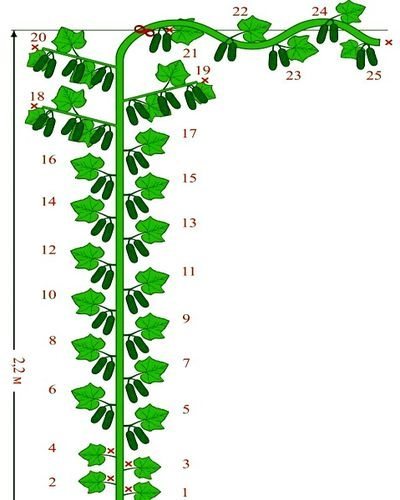

Then, after the main stem reaches the upper edge of the trellis (that is, a height of about 2-2.5 meters), only the lateral shoots are removed in its axils, and all the ovaries are left.
Another option is possible when one leaf is left in the axils in the middle part of the main stem, and two in the upper part. That is, pinch the lateral shoots after the second and third leaves, respectively. In the future, the main stem is directed along the upper edge of the trellis and, when the top reaches the neighboring bush, it is pinched.
This formation of a cucumber bush makes it possible to form and ripen the maximum number of ovaries.
How to plant Courage on the site
There are two ways to grow a hybrid: seeds and seedlings. The first option is suitable for warm regions with hot summers and rich soil. Seedlings to grow Courage should be gardeners from regions with an unfavorable climate.
Seed preparation
The quality and quantity of the crop depends on which seeds were used, how the seed was prepared. For better germination, it is necessary to carry out the following preparatory measures:
- disinfect seeds with saline;
- disinfect with a slightly pink solution of potassium permanganate;
- immerse in Epin's solution prepared according to the instructions;
- germinate planting material with boric acid.


Timing and disembarkation
To get the harvest as early as possible, sowing the Courage cucumbers should be by the end of April or the beginning of May. Seedlings should be planted in a permanent place only after the threat of frost has passed (for example, in the middle lane it is not recommended to do this earlier than mid-June).
Seed directly into open ground
In regions where warm days come earlier, the hybrid can be planted in open ground, bypassing the stage of growing seedlings.You must first prepare the beds: it is best if potatoes, cabbage or legumes have been growing on them before. The soil needs to be dug deeply, covered with a film so that the earth warms up. Sowing seeds is done on the garden bed, it is not necessary to over-deepen the planting material. On top of it, soil should be poured about one and a half centimeters high. Row spacing should be 50 centimeters.
Helpful information! Sowing seeds in open ground is possible only when the ground is well warmed up, and the temperature regime is at least +15 degrees. Covering with a film will help protect crops from low temperatures and return frosts.
Planting through seedlings
In order to get the most generous harvest of Courage cucumbers, it is necessary to plant cucumbers in seedlings. The rules for growing seedlings are quite simple: firstly, it is important to maintain an optimal temperature regime. In the room where the box with sown seeds is located, the temperature should be + 28 ° C. After the shoots appear, the temperature must be reduced to +19 degrees. The boxes should be placed on the windowsills, the soil should be moistened in a timely manner.
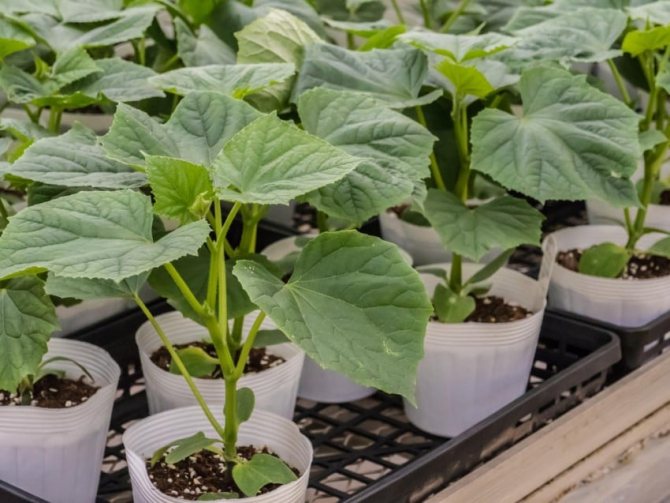

When four leaves are formed on the seedlings, and the root system is sufficiently well developed, the seedlings can be transplanted to a permanent place. It is best to perform this procedure in the morning or evening, as direct sunlight and high temperatures can harm the seedlings. After transplanting, courage must be thoroughly watered and covered with foil.
See also How many days do cucumber seeds sprout after sowing: the reasons for the lack of germination
Yield
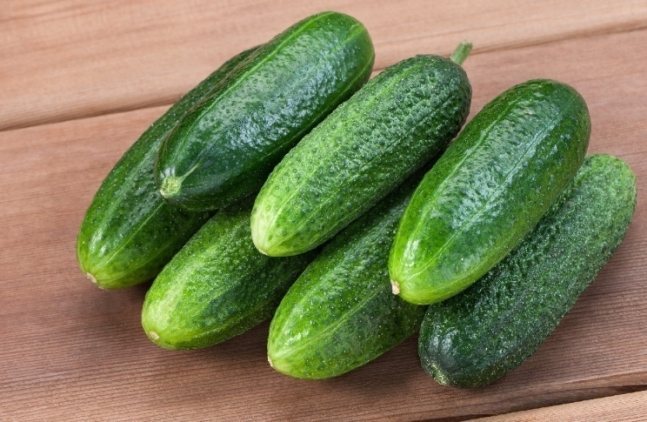

In their recommendations, breeders indicate that exceeding the planting density of a crop will inevitably lead to a loss of yield. 2 plants are planted on 1 m².
The very first cucumbers should be picked when they reach 10 cm, without overexposing the greens. Active harvesting provokes the growth of ovaries, and the yield increases markedly. When following simple recommendations, it is quite possible to collect 10 kg of cucumbers from a bush.
But already the second crop turnover will be slightly less, and is unlikely to exceed 8 kg per bush. In addition, late sowing also slightly reduces yields, as daylight hours are reduced closer to autumn. Therefore, seedlings are planted at the very beginning of summer. The last disembarkation for the autumn gathering is at the end of July.
In greenhouses, if additional lighting is available, Courage can be grown year-round.
Affects the yield and excessive leafiness of the crop. Large leaves reduce the illumination of the entire plant, smaller leaves turn yellow and die off. Following them, the ovaries slowly die off. To prevent crop loss for this reason, the lazy leaf blades are partially removed, but the stalks must be left behind.
Transferring seedlings to the ground step by step
Cucumber seedlings are transplanted to a permanent place 25 days after the shoots have appeared:
- to greenhouses - April 15;
- in film-covered soil - May 10;
- on open beds - at the beginning of summer.
Before starting the transfer of seedlings, you will need to stock up on water for irrigation, organic fertilizing and a shovel.
Table. Transferring cucumber seedlings - step by step instructions.
| Steps, photo | Description of actions |
| Step 1 | Make small holes in which the plants will be planted. Moisten the soil in the holes and fertilize it with manure or compost. |
| Step 2 | Remove the seedling by gently inverting the seedling container. The soil must be left on the roots. |
| Step 3 | Very carefully, trying not to harm the plant, plant it in a hole, moisten it with water and cover it with a layer of soil. |
| Step 4 | Just as carefully, you should tie the plant stem to the support. |
Features of growing in a greenhouse
If the cucumbers of the Courage variety are grown in a greenhouse, the following features should be taken into account:
- In autumn, the surface of the soil must be cleaned of plant residues and weeds.At the same time, it is advisable to change the top layer of soil 5-7 cm thick 2-3 times a year in order to remove all pathogenic microflora from the greenhouse. The lack of substrate can be replenished with a mixture of loam and compost or transferred manure in a 1: 1 ratio. In the spring, it is worth digging up the beds again and applying mineral fertilizers - 30 g of urea, 40 g of superphosphate and 20 g of potassium dressing per 1 sq. m.
- Form the bushes into one stem to increase the crop yield.
- Remove lateral shoots from the main stem in the axils of 4 formed leaves.
- There is no need to adjust the number of ovaries.
- Provide the plant with a good level of light.
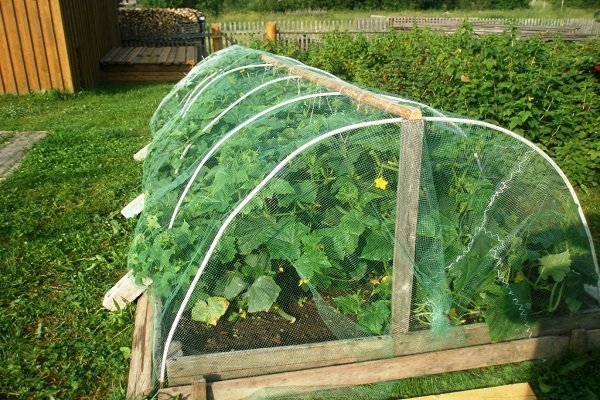

If the leaves begin to wither, they should be watered or sprayed with a warm solution of chalk (200-250 g per 10 l). This procedure will significantly lower the air temperature in the greenhouse and raise its humidity level.
Where can you plant cucumbers?
Courage is an ideal variety for growing outdoors and in greenhouses by sowing seeds in a garden bed or using seedlings. Planting crops in open beds is allowed to begin after the threat of frost has passed and the average daily temperature is kept at around + 15 ° C. Usually, gardeners use the method of growing cucumbers in the open field in the warm season. The soil on the site must be fertile and neutral, since land with high acidity is not suitable for Courage. To reduce the acidity of the soil, from the fall, fluff lime (per 100 sq. M. - 60 kg) or wood ash (per 100 sq. M. - 70 kg) are introduced. Such an event is held every 4-5 years. For the garden it is necessary to choose an illuminated and protected from the wind place.
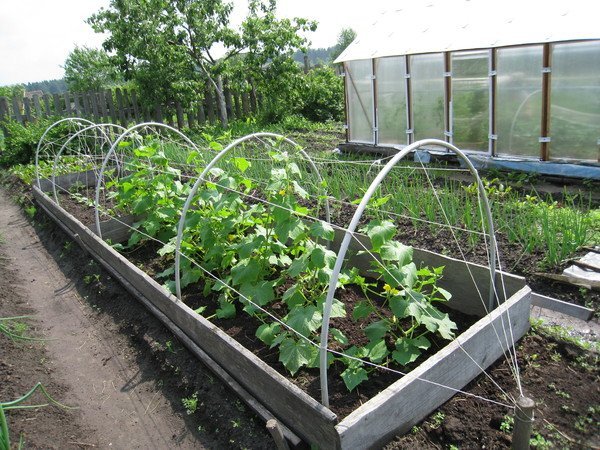

Choose a place protected from cold winds for cucumbers
Photo gallery
The photo shows fungicides used in the fight against diseases of cucumbers.
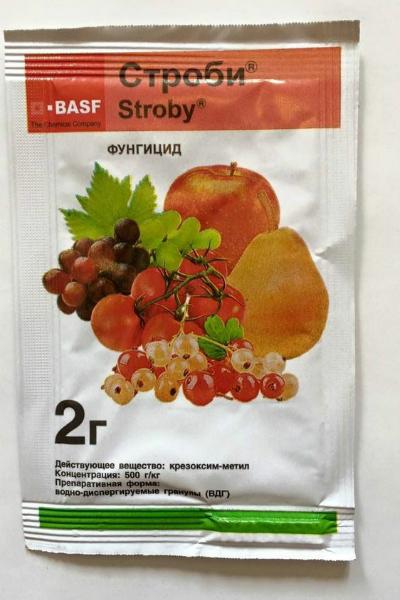

Strobe, price 40 rubles
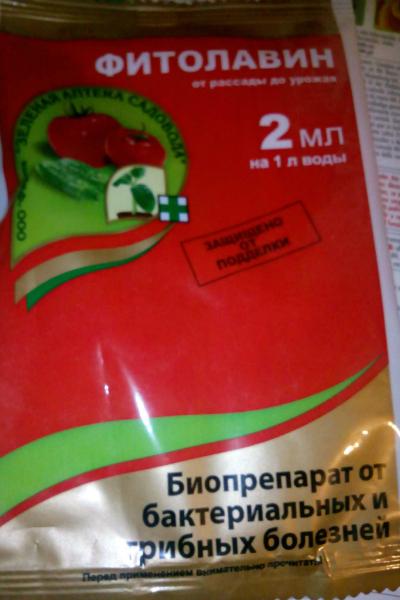

Fitolavin, price 300-20 rubles
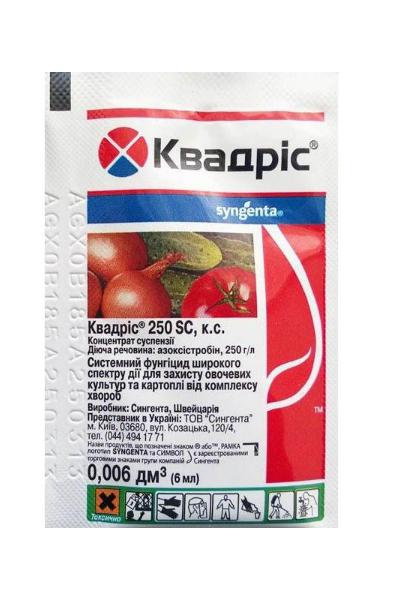

Quadris, price 30 rubles
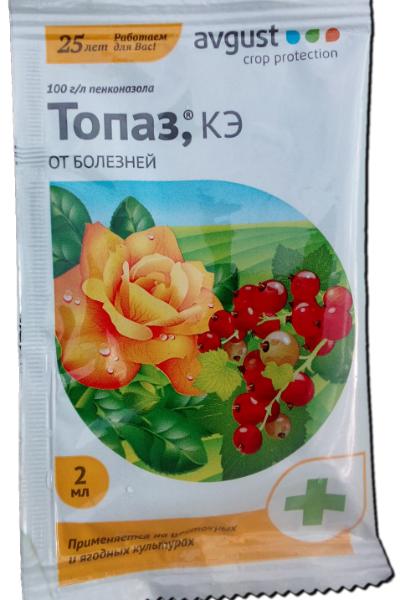

Topaz, price 33 rubles
Description of Zelenets
The most important factor when choosing a cucumber variety is the taste of the future harvest. After all, a sweet, aromatic cucumber can become a real delicacy for adults and children. So, it is the amazing taste that is the main and most significant advantage of the "Courage f1" cucumber variety.
Zelentsy "Courage f1" have a pronounced fresh aroma. When breaking a cucumber, you can hear a characteristic crunch. Its pulp is dense, juicy, sweetish, absolutely devoid of bitterness. Cucumbers can be used for pickling, pickling, canning, making salads and even soups. Wonderful vegetables of the "Courage f1" variety can become a "highlight" of every table, since the special taste of green tea surprises not only when freshly consumed, but also after salting and heat treatment. In winter and summer, the cucumber "Courage f1" will delight the hosts and guests of the house with its presence on the table.
The external description of the greenery is excellent: the length of the cucumber is at least 13 cm, the shape is classic for the culture - oval-cylindrical, aligned. The average weight of each vegetable is 120-140 grams. In cross-section, the diameter of the fruit is 3.5-4 cm. On the surface of the cucumber, numerous bumps and thorns of white color can be observed. You can see the cucumbers of the "Courage f1" variety below in the photo.
Features of agricultural technology varieties
To provide your plantings with maximum fruiting, you need to take care of growing seedlings. This method is most suitable. Seeds treated with a growth stimulant are planted in warm soil. The boxes must be exposed to the sun, otherwise the number of ovaries will be reduced. When the first few leaves appear, the seedlings can be moved to the greenhouse. To do this, choose cloudy days or evening. For 1 sq. meter should be no more than two plants.
Cucumbers are fed with organic fertilizers, but only until the period of ovary formation. Other prerequisites for the normal development of culture will be regular, but not excessive watering, loosening of the soil.The formation of bushes will save the plant from the need to spend energy on excess greens, which inhibits ripening. Fruits are stored without loss of marketability for 10 days after harvest.
Important!
It is necessary to harvest on time, even a small delay will prevent the appearance of new ovaries and negatively affect the taste of the fruit.
Pests and diseases: control measures
The undoubted advantage of the Courage variety over other representatives is that they are not very susceptible to pests and diseases. If, nevertheless, some kind of attack has overtaken, it is recommended to start the fight in time so as not to ruin the entire crop. Here are the most common diseases that cucumbers suffer from and try to consider the pests of vegetable crops.
- Cladosporium. The appearance of gray-brown spots on the leaf plates indicates the presence of this disease. Through holes are formed in the affected areas, the leaves die off, the plant lags behind in development. For prevention purposes, it is recommended to thin out the plantings, remove dense foliage. You need to treat it by spraying the borage with a solution of Bordeaux liquid. Requires 2-fold treatment with an interval of 7-9 days.
- Anthracnose. Dead areas can be observed on the leaf plates. The fruits become twisted, dents with pink mucus form on the sides. Vegetables acquire a bitter taste, it becomes impossible to eat them. Copper oxychloride is used for spraying. You cannot pick vegetables during processing.
- Thrips. Mass damage by thrips leads to the death of the planting, since small insects feed on borage juice. It is possible to determine that a shallow sucking insect has started on the plants by the rapidly growing yellow and beige spots. If you do not start treatment, the bush will dry out. For prevention purposes, it is recommended to dig up the beds every autumn to the depth of a bayonet-shovel and spray with a solution of Actellik or Kabofos preparations.
Of the folk remedies for combating the pest, the most effective way can be called - the treatment of plantings with hot pepper infusion.
Cucumbers Courage is a high-yielding multi-purpose variety. With the observance of agricultural technology, you can get a good harvest. Zelentsy are suitable for fresh consumption, for canning, salting, and retain their presentation for a long time.
How to harvest and store crops correctly?
Courage fruits must be removed every 2 days, otherwise they will outgrow and interfere with the formation of new greens. After the first frost, the fruits are harvested in a row.
- fruits must be cut with a knife so as not to damage the plant, leaving the stalk on the stem, without turning or shifting the whips;
- the best time to harvest is early morning or evening.
Methods for storing cucumbers
- the fresher the cucumbers are, the longer they will last in the refrigerator. In a loosely closed bag, they remain fresh for at least a week;
- pouring cucumbers with water and putting the bucket in a cool place, you can save them for 3-4 days with regular water changes;
- greens can be coated with egg white. This method will allow you to store fruits without a refrigerator;
- a large number of fruits can be stored in boxes on special racks. Courage retains its freshness and presentation for up to 10 days, regardless of conditions.
Labor Reward: Harvesting
How to pick cucumbers?
You can start harvesting Courage from about mid-July. This should be done at least every 2 days. Overexposing cucumbers on bushes is undesirable for several reasons:
- this slows down the ripening of the remaining fruits;
- taste deteriorates, and the skin coarsens. The most delicious cucumbers are unripe.
The optimal length of the fruit ready to go to the table or to the jar is up to 10 cm. Gathering should be scheduled early in the morning or late in the evening. It is better to use pruning shears or sharp scissors so as not to injure the whip and leave the stalk on it.
Do not overturn leaves and whips to avoid damaging the plant.
Where and how much to store Courage F1?
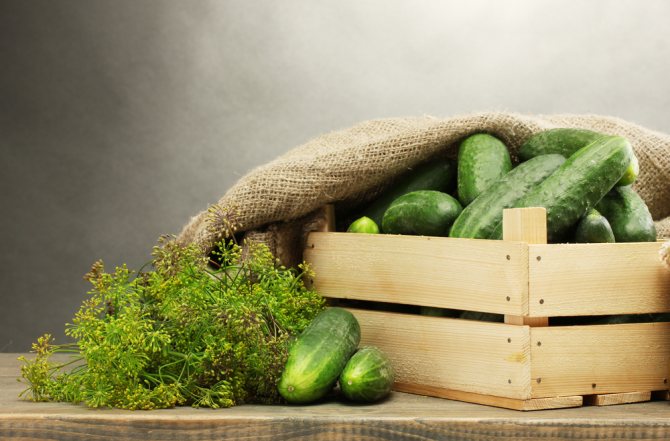

The best storage container is a wooden box
At temperatures up to 10 ° C, the harvested crop will lie for about a week, or even all 10 days, without losing its pleasant taste and marketable appearance. The main thing is to provide the cucumbers with suitable conditions:
- high humidity (up to 90%);
- protection from sunlight;
- Shelter with opaque but breathable material.
If you put Courage in a cellar, then at a temperature of 0 ° C it will lie for about a month. It is stored by laying it in one layer on wooden pallets, boxes or cardboard boxes, the bottom of which is covered with foil. The harvested fruit must be free from defects.
Please note: at room temperature, Courage becomes sluggish after 2-3 days.
How to use the harvested fruits?
Courage is delicious fresh, so many gardeners are not too lazy to prepare salads with it every day. A cucumber of this variety is also suitable for processing in different ways:
- pickling;
- fermentation;
- use in combination with other vegetables in cold dishes.
Watering and feeding
Most gardeners are not in the business of shaping the Courage cucumber. Bushes are formed only in a greenhouse, where it is not possible to freely place all the whips (Figure 7).
But this does not mean at all that plants can be left completely without care:
- Watering: carried out as the top layer of the soil dries up. It is impossible to moisten the soil too much, as this can provoke an outbreak of fungal diseases.
- Loosening and weeding: are needed to destroy the earthen crust, which does not allow air to flow to the roots. The procedure is carried out after precipitation or watering, when the moisture is completely absorbed into the soil.
- Top dressing: carried out until the formation of ovaries. Better to use organic matter. But when the ovaries are formed, fertilization is stopped, since this will give the greens an unpleasant taste.


Figure 7. Cucumbers need frequent but moderate watering. If the plants grow too much, a bush is formed. In the process, extra stepsons and leaves are removed, since they reduce the yield of the crop and lead to thickening of the crown, which in turn is fraught with the development of fungal diseases.
Care and watering
The Kurazh hybrid needs maintenance and watering, which is standard for all varieties. It is advisable to water the plants with settled and warm water, and in hot weather you need to mulch the beds. Long breaks in irrigation activities can affect:
- to shedding ovaries;
- on the appearance of bitterness in fruits;
- to slow down the growth of bushes;
- to reduce disease resistance.
Table: watering in open beds
| Watering time | Periodicity | Volumes |
| Before flowering | every 4-5 days, focusing on the air temperature | 5-7 liters per 1m2 |
| Flowering and fruiting | everyday | 6-12 liters per 1m2 |
Watering cucumbers is recommended in the evening. For an uninterrupted process of watering cucumber crops, you need to put containers in the summer cottage, which are filled with water from a hose in the evening. During the day, the water warms up enough and is ready for watering in the evening.
Considering that the roots of the plants are near the surface of the ground, it is impossible to use a strong pressure of water, so as not to damage the root system. When watering, you need to make sure that the water does not get on the leaves, otherwise the bushes can get sick.
Table: plant feeding in the open field
Cucumbers in the open field need to be fed a little, but quite often - 5-6 times per season. Fertilizers are applied at the root or by foliar dressing.
| The sequence of dressings | Application time | Means and proportions |
| First feeding | the appearance of two real leaves | water - 10 l, urea - a tablespoon |
| Second feeding | 2 weeks after the first | water - 10 liters, mullein - 0.5 liters |
| Third feeding | beginning of flowering | any store potash fertilizer - according to the instructions, or solution: water - a bucket (10 l), ash - 2 glasses, urea - 10 g |
| Fourth, fifth and sixth | fruiting period, as needed | water - 10 l, chicken droppings - 0.5 l, ash - 1 glass |
Table: watering in greenhouses
For watering cucumbers in greenhouses, special grooves are made along the planting and exclusively warm water is used.
| Watering time | Periodicity | Volumes |
| From planting bushes to flowering | every 5-7 days | 5-6 liters per 1m2 |
| Flowering period | every 2-3 days | 8-10 liters per 1m2 |
| Ovary formation, fruiting period | in one day | 15-18 liters per 1m2 |
On cloudy and cold days, watering is skipped.
If the leaves of the plants begin to wilt, watering is required immediately. To prevent the cucumber bushes in the greenhouse from overheating, the outside of the greenhouse should be sprayed with an aqueous solution of low concentration chalk.
Table: feeding plants in the greenhouse
The culture growing in the greenhouse, as well as in open beds, needs to be fed in small quantities. It will be enough to fertilize the bushes 4-5 times a season.
| The sequence of dressings | Application time | Means and proportions | Method of application and quantity |
| First feeding | the appearance of 3-4 true leaves | water - 10 l, potassium sulfate - 15 g, double superphosphate - 20 g, ammonium nitrate - 10 g | enough to water 10-15 plants |
| Second feeding | flowering time | water - 10 l, liquid mullein - 0.5 l, nitrophoska - 1 tablespoon, ash - a glass, boric acid - 0.5 g, manganese sulfate - 0.3 g | 3 liters of solution per 1m2 |
| Third feeding | fruiting period | water - 10 l, ash - a glass, urea - 15 g | watering |
| Fourth and fifth feeding | fruiting period | water - 15 l, liquid chicken manure - 1 l | watering |
Agronomist tips for growing cucumbers
If you want to have a good cucumber harvest, then we definitely need to know the advice of an agronomist on growing cucumbers in a vegetable garden. Cucumber is one of the most beloved vegetable crops in the garden. We all love cucumbers for their excellent taste, and we try to breed them as much as possible in our garden plots. In whatever natural conditions the garden is located, you will always create the necessary growing conditions for them.
The content of the article:
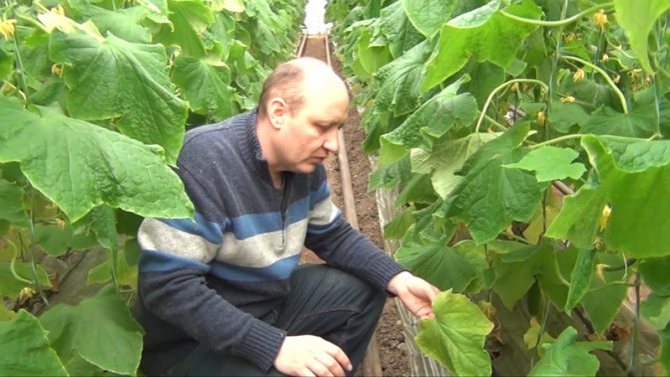

Harvesting and storage rules
Cucumbers Sankina Lyubov
The first fruits appear in mid-July. With proper care, up to 10 kg of vegetables can be harvested from one bush. When planting 3 bushes per 1 m2, the yield will be up to 20 kg.
Important! You should not wait for the full maturity of the cucumbers. Vegetables must be harvested still unripe, since full ripening is allowed only if the goal is to collect seeds.
Harvesting is carried out 1 time in 2 days. If the cucumbers are overexposed on the bush, their taste will deteriorate, bitterness will appear, and the skin will become tougher. In addition, untimely harvesting slows down the ripening of freshly set fruits.
The first greens are recommended to be removed when their length reaches 10 cm. This is necessary to stimulate the formation of fruits, and not for the development of the bush and the growth of green mass.
Cucumbers are best picked early in the morning or late in the evening. During this time, it can be ensured that the vegetables are firm and do not contain empty cavities. During collection, you cannot pull cucumbers and twist, trying to detach the green from the stalk. It is recommended to work with scissors, as the stalk should remain on the growing shoot.
The collected fruits do not lose their presentation, taste within 8-9 days, only they must be removed to the basement, where it is dark and humid. Additionally, you need to cover the cucumbers with a dark non-woven material, you can use burlap.
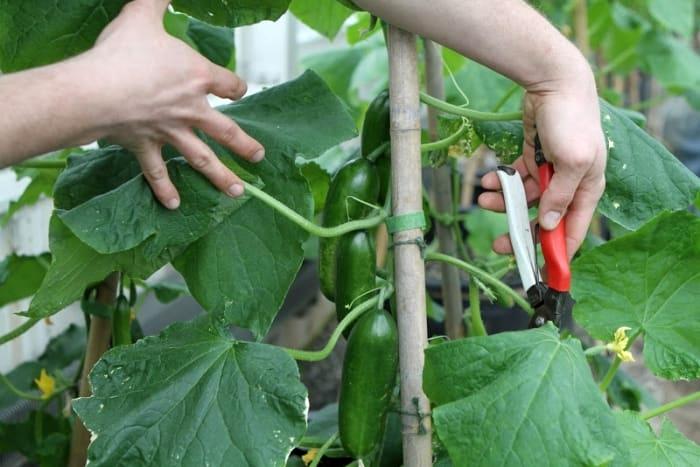

Care
Taking into account the fact that the skin of cucumbers of the Courage variety is rather thin, when stored at room temperature, vegetables will lose turgor for 2 days, they will be flabby and lethargic.
Table: Pests attacking the plant
| Signs of defeat | Pest | Protective measures |
| White dots become noticeable on the leaves, then signs of yellowing and wilting appear. | Spider mite | Metafox, Fufanon, Akartan will help.The drugs need to be alternated, since the tick quickly develops immunity to them. For minor lesions, you can use a garlic tincture diluted with water in a 1: 5 ratio. |
| Seedlings wither | Sprout fly | Preliminary digging of soil, the use of Kemifos, Iskra and so on are shown. They water the beds before planting plants or sprinkle young shoots. |
| Sticky silvery traces are visible on the leaves, the stems and fruits are nibbled | Slugs | Special drugs - for example, Meta or Thunderstorm - are very toxic not only to pests, but also to humans. Therefore, it is better to collect slugs with tweezers or make traps from containers with beer or sugar syrup (they are dug in next to cucumber beds). Another effective method is the creation of a thorny barrier from pine needles, gravel, brick chips, broken slate |
Photo gallery: What do harmful insects look like?
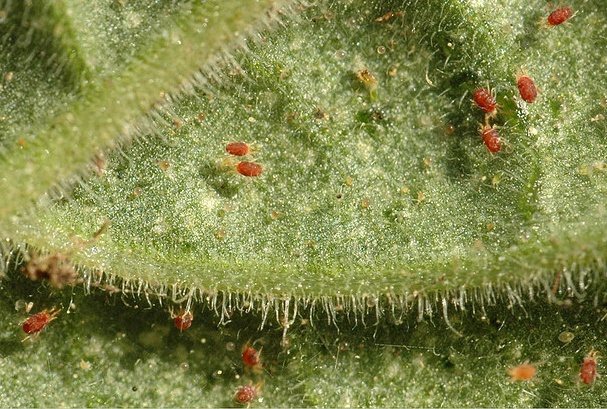

Due to ticks, which are susceptible to Courage, the leaves turn yellow and wither over time
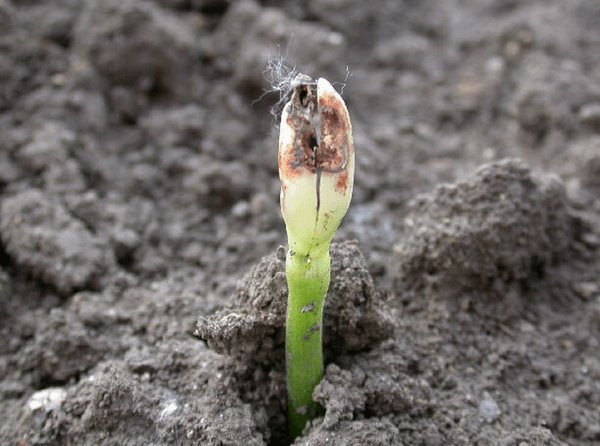

Growth fly loves young shoots of cucumbers
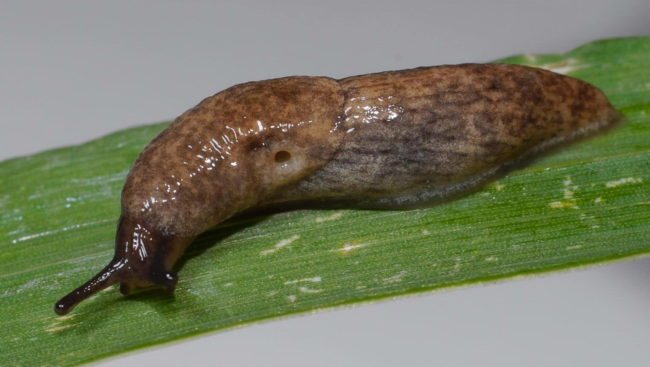

Collecting slugs by hand is easy but troublesome. Better to use traps
Cultivation of culture
The F1 Courage loves fertile, loosened soil. The predecessors of cucumbers can be cabbage, potatoes, and onions. Vegetables are grown in a seedling or non-seedling way. If the seeds are sown in early May, the first cucumbers can be harvested in June.
Landing dates
It is advisable to pre-sow the seeds for seedlings in early May, in peat cups. You can use plastic containers with a volume of 0.5 liters. Saplings do not like to be disturbed by their roots. Cucumbers do not dive. When transplanting to a garden bed, young plants are transferred along with an earthen lump. If they are transplanted into the garden in mid-May, then fresh cucumbers can be picked in June.
Courage can be grown in a seedless way, and sow seeds in the garden at the end of May. The crop can be removed in July. If you sow seeds in mid-summer, cucumbers will begin to bear fruit closer to fall.
Hybrid seeds are not cheap. Manufacturers pre-treat the seed with pesticides, which is why the color of the seeds is emerald. Such a seed does not need to be soaked before sowing. Untreated seeds can be dipped in a pink potassium permanganate solution for 25 minutes. Light seeds can be disinfected with Epin-Extra, Baikal EM-1 preparations. The probability of emergence of seedlings is 95%.
See also
Description of the early ripe cucumber Cedric, cultivation and proper care
To read
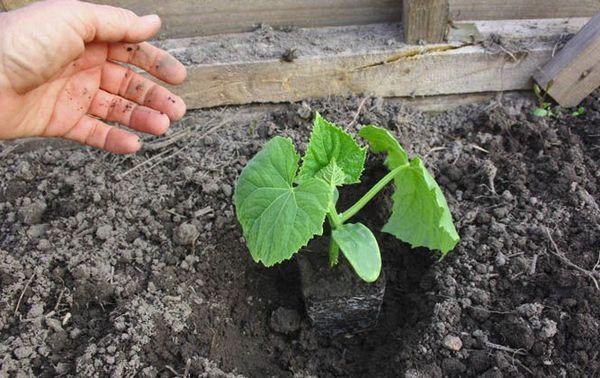

Seat selection
The culture prefers places that are slightly shaded, well protected from drafts and wind. The plant does not tolerate summer heat. Courage F1 loves well-fertilized, non-acidic soil. To reduce acidity, 500 grams of wood ash or lime is introduced per 1 meter of a square plot.
Preparation of beds and crops
Previously, the bed must be dug up, loosened and fertilized with organic matter and minerals. For one square meter, 1 bucket of rotted humus or compost, 30 grams of phosphate and potassium fertilizers are introduced.
Protection against diseases and pests
Despite the fact that courage cucumbers are resistant to diseases such as powdery mildew, mosaic and root rot, they can be affected by other pathologies.
These include:
- Fusarium: develops very quickly, and the plant may die within the first days after infection. As a rule, the disease manifests itself on plants whose seeds have not been disinfected before sowing. All diseased specimens must be removed from the garden and burned.
- Anthracnose: fungal disease, which is accompanied by the formation of yellow spots on the leaves. Dents with a pink bloom are formed on the fruits. Sick bushes are destroyed, and the remaining ones are sprayed several times with Bordeaux liquid or copper preparations.
- White rot: may appear in humid conditions. It is accompanied by the formation of white spots on leaves, shoots and fruits.The affected areas are cut out, and the plant itself is sprayed with a mixture of copper sulfate (2 grams) and urea (10 grams), dissolved in a bucket of water.
If the cucumbers grow too densely, or there are a lot of weeds in the garden, aphids or spider mites can settle on the bushes. In most cases, insecticides are used to control them.
A detailed description of cucumbers of the domestic variety Courage can be found in the video.
Diseases and pests of indoor cucumbers
Cucumbers of the Kurazh F1 variety grown in greenhouse conditions can be infected with fungal or viral infections.
Table: methods of control and prevention
| Disease / pest | Signs of damage in a plant | Ways to fight | Preventive actions |
| Anthracnose - a fungal disease | The appearance of round yellow-brown spots on the leaves. Over time, the spots dry out and become brittle, pinkish scars or ulcers appear on the fruits. | Infected cucumbers are destroyed, they cannot be eaten! The diseased plant is sprayed with 1% Bordeaux liquid. |
|
| White rot is a fungal disease | The appearance of a white fluffy bloom on leaves, stems, fruits. Over time, the plaque softens and becomes slimy. The infection persists in the ground. | Before planting, the soil in the greenhouse is treated with manganese (5 g per 10 l of water). The affected parts of the plant are removed, and the places of the cuts are sprinkled with lime or copper sulfate. | |
| Greenhouse whitefly | Blackening and drying out of the green parts of the plant. |
|
Photo gallery: diseases and pests of indoor cucumbers
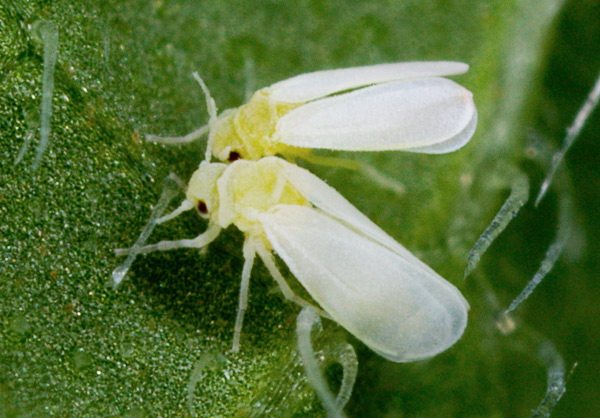

Greenhouse whitefly prefers wet and shady places
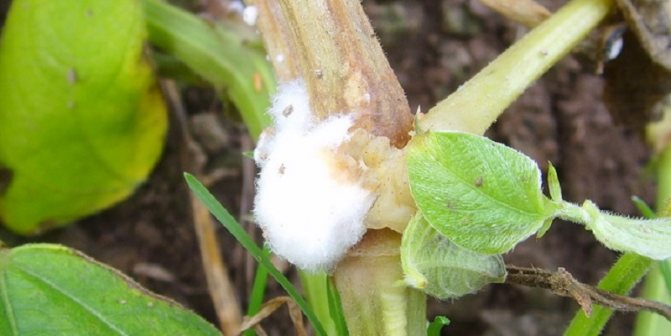

White rot develops on all parts of the plant - from roots to fruits
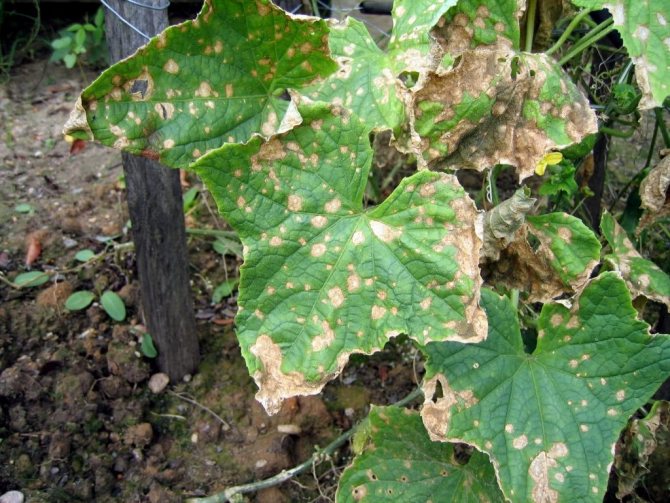

Anthracnose is ubiquitous, but cucumbers are most damaging in plastic greenhouses.

